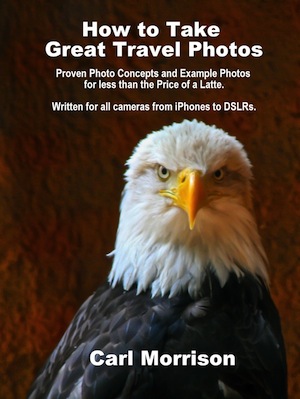 This large photo in the Polo Lounge indicates that there might have been a polo grounds in the area.
This large photo in the Polo Lounge indicates that there might have been a polo grounds in the area.
 The front porch has a bar and seating at tables and wooden chairs
on out on the lawn. Guests come in the side entrance nowadays so
this porch is a quiet place.
The front porch has a bar and seating at tables and wooden chairs
on out on the lawn. Guests come in the side entrance nowadays so
this porch is a quiet place.

A walk through the front porch and
yard, then east on the street allows a view of the therapy pools.
Circling around the east end of the pool one can find the Glenwood Hot
Springs pool house entrance.


A few steps up to the pedestrian
walkway and across the city street, I-70, the railroad, and Colorado
River and you are back at either downtown Glenwood Springs, the
Glenwood Brewery, or the train station.

The photography bridge is a good
location from which to take a shot of the station and Denver Hotel with
the river and tracks in the photo. My title shot for this report was taken from here as well.

Looking north from the pedestrian
bridge or your trackside window in the Hotel Denver, you can spot the
Iron Mountain Tramway which takes visitors to the Glenwood Caverns
Adventure Park. One can also see the Cliffhanger Roller Coaster
high on the mountain's edge.
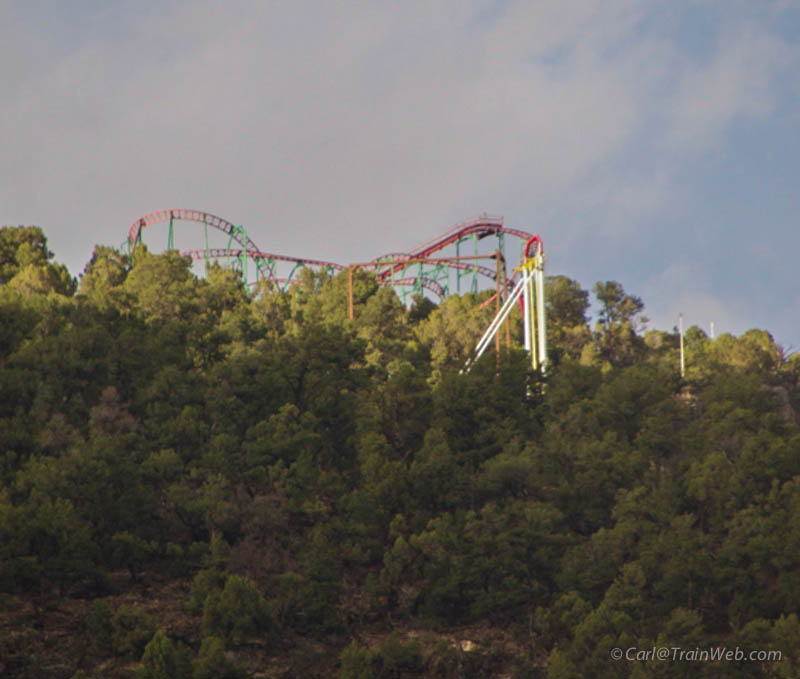
Eateries in downtown Glenwood Springs, Colorado
About sunset, we strolled west from the Hotel Denver on 7th Street in
search of a nearby restaurant for supper. We passed plenty of popular
eating establishments with waiting lists on this September Wednesday
evening.


We settled on Doc Holliday's Saloon, partly because there was no waiting list, and more importantly because they had good food. Overheard at the Glenwood Canyon Brewing Company, "Food in a bar is better than a drink in a restaurant."

John Henry "Doc" Holliday (August
14, 1851 – November 8, 1887) was an American gambler, gunfighter, and
dentist of the American Old West who is usually remembered for his
friendship with Wyatt Earp and his involvement in the Gunfight at the
O.K. Corral.
As a young man, Holliday earned a D.D.S. degree and set up a dental
practice in Atlanta, Georgia. In 1873 he was diagnosed with
tuberculosis, the same disease that had claimed his mother when he was
15. He moved to the American Southwest in hopes that the climate would
prolong his life. Taking up gambling as a profession, he subsequently
acquired a reputation as a deadly gunman.
During his travels, he met and became good friends with Wyatt Earp and
his brothers. In 1880, he moved to Tombstone, Arizona, and participated
alongside the Earps in the famous gunfight. This did not settle matters
between the two sides, and Holliday was embroiled in ensuing shootouts
and killings. He successfully fought being extradited for murder and
died in bed at a Colorado hotel at the age of 36.
The legend and mystique of his life is so great that he has been
mentioned in countless books and portrayed by various actors in
numerous movies and television series. For the 125-plus years since his
death, debate has continued about the exact crimes he may have
committed.
--http://en.wikipedia.org/wiki/Doc_Holliday
Doc Holliday's grave is in Linwood Cemetery, a short hike from 12th and
Bennett Street, according to the "Official Glenwood Springs Chamber
Resort Association's Trail & City Map 2013-2014." Pioneer/Linwood Cemetery is located just east of Glenwood Springs atop Jasper Mountain. Vehicles are not allowed on the road to the cemetery.

The following day, we decided to
drive up Hwy. 82 to Aspen. Paralleling the highway on an old
railroad right of way is the Rio Grande Bike Trail. Before
departing, we had breakfast at Daily Bread, a short walk from the Hotel
Denver.

Aspen, Colorado, a nice day trip from Glenwood Springs
While doing desk research on Glenwood Springs, I discovered that
Aspen was close enough to visit as a day trip (about 150 miles via
4-lane highway) in a rental car or a bus from Glenwood Springs.
My traveling companions had attended summer seminars in Aspen and knew
of St. Benedict's Monastery near Snowmass on the way.

Soon after departing Glenwood Springs southbound, I spotted lighter-than-air travel off the cliffs.
St. Benedict's Monastery

St.
Benedict's Monastery is a monastery in mountainous country of the U.S.
state of Colorado. It is located in Pitkin County in the unincorporated
town of Snowmass about 18 miles (29 km) northwest of Aspen. The monks
are members of the Order of Cistercians of the Strict Observance,
commonly called the Trappists.
Currently the monastery is home to about 16 monks. The monks live
communally in the monastery. Their day is balanced by prayer, work,
reading, and contemplation.
St. Benedict's is located on over 3,000 acres (1,200 ha) of a scenic,
semiarid valley in the foothills of the Elk Mountains, near the Maroon
Bells-Snowmass Wilderness. The monastery protects a large amount of
open space in a sensitive area near important wildlife migration
routes. The monks manage their ranchlands, operate a cookie bakery, and
offer retreat facilities for groups and individuals. The retreat house
and guest hermitages are located about 1 mile from the main monastery
building.
The monastery was founded in 1956 as a foundation established by the
Trappist community at St. Joseph's Abbey in Spencer, Massachusetts. The
community celebrated its 50th anniversary in 2006.
St. Benedict's is the home of Father Thomas Keating, a popular writer
on Centering Prayer and one of the founders of Contemplative Outreach.
--From http://en.wikipedia.org/wiki/St._Benedict%27s_Monastery_%28Colorado%29
The Bookstore was the highlight for Tim and Don.




On to Aspen
Aspen is a city in and the county seat of Pitkin County, Colorado,
United States. It is situated in a remote area of the Rocky Mountains'
Sawatch Range and Elk Mountains, along the Roaring Fork River at an
elevation just below 8,000 feet (2,400 m) above sea level on the
Western Slope, 11 miles (18 km) west of the Continental Divide. As of
the 2010 census, there were 6,658 permanent residents.
Founded as a mining camp during the
Colorado Silver Boom and named because of the abundance of aspen trees
in the area, the city boomed during the 1880s, its first decade of
existence. That early era ended when the Panic of 1893 led to a
collapse in the silver market, and the city began a half-century known
as "the quiet years" during which its population steadily declined,
reaching a nadir of less than a thousand by 1930. Aspen's fortunes
reversed in the mid-20th century when neighboring Aspen Mountain was
developed into a ski resort, and industrialist Walter Paepcke bought
many properties in the city and redeveloped them. Today it is home to
three renowned institutions, two of which Paepcke helped found, that
have international importance: the Aspen Music Festival and School, the
Aspen Institute, and the Aspen Center for Physics.
In the late 20th century, the city
became a popular retreat for celebrities. Gonzo journalist Hunter S.
Thompson worked out of a downtown hotel and ran unsuccessfully for
county sheriff. Singer John Denver wrote two songs about Aspen after
settling there. Both of them popularized Aspen among the
counter cultural youth of the 1970s as an ideal place to live, and the
city continued to grow even as it gained notoriety for some of the
era's hedonistic excesses as well, particularly its drug culture.
Today the musicians and movie stars
have been joined by corporate executives. As a result of this influx of
wealth Aspen boasts the most expensive real estate prices in the United
States and most middle-class residents can no longer afford to live
there. It remains a popular tourist destination, with outdoor
recreation in the surrounding White River National Forest serving as a
summertime complement to the four ski areas in the vicinity.
The downtown has been largely
transformed into an upscale shopping district that includes high-end
restaurants, salons, and boutiques. Aspen boasts Ralph Lauren, Dior,
Louis Vuitton, Prada, Gucci, Fendi, Bvlgari, Burberry, Brioni, theory
and Ermenegildo Zegna boutiques.
--From http://en.wikipedia.org/wiki/Aspen,_Colorado


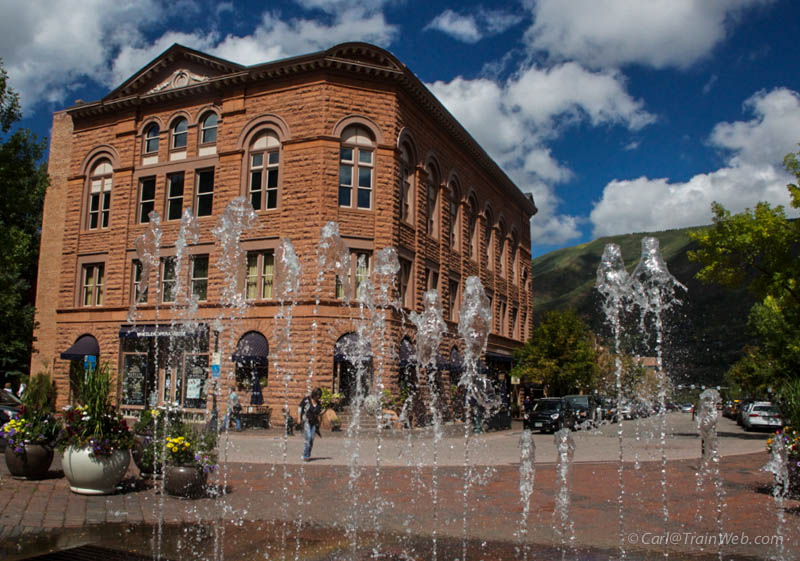


I chatted with Alex at The Vickers Collection 525 E. Cooper Ave Unit 107 Aspen, CO 81611 970.925.9484 info@vickersart.com

 A park not far from the Court House is this chrome bumper art piece, El Conquistador by Lou Wille
A park not far from the Court House is this chrome bumper art piece, El Conquistador by Lou Wille
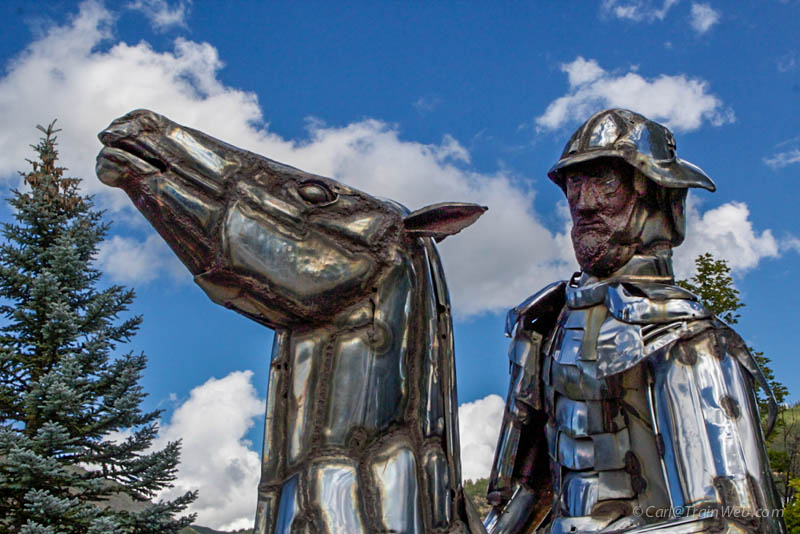
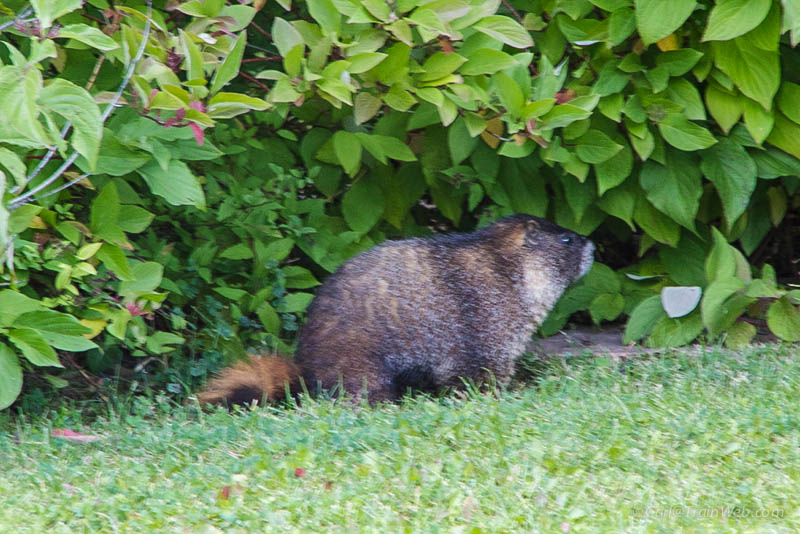 This wood chuck was also loitering in the same park.
This wood chuck was also loitering in the same park.

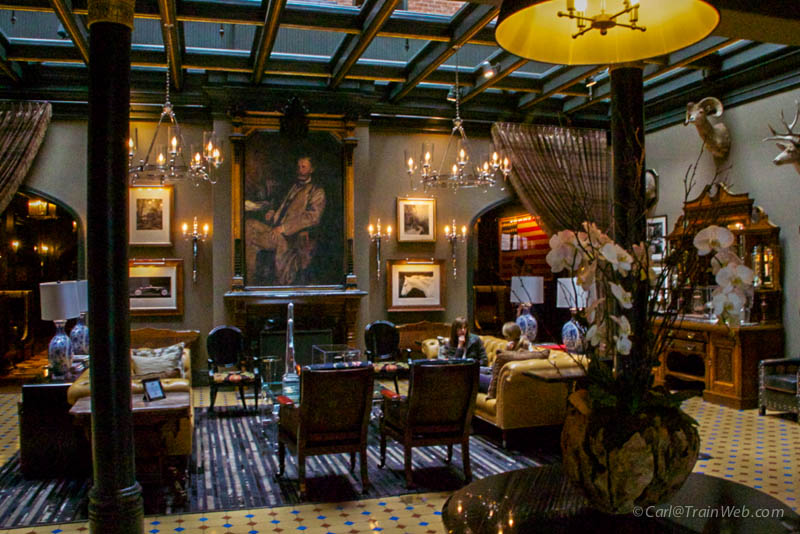

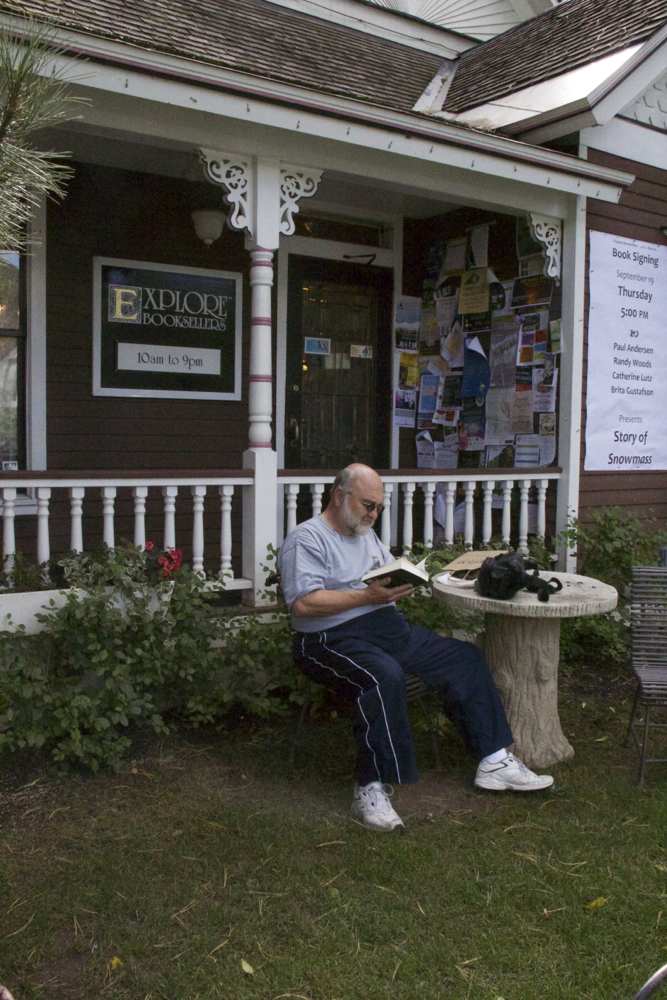
Don reading after a visit to Explore Booksellers.
 The most expensive Interstate in the system through Glenwood Canyon with a bike trail, the Colorado River, and the railroad.
The most expensive Interstate in the system through Glenwood Canyon with a bike trail, the Colorado River, and the railroad.
We learned that the California
Zephyr westbound from Glenwood Springs had been rerouted through
southern Wyoming starting in Denver. Rather than face an Ambus
ride from Glenwood Springs to Salt Lake City to meet it, Tim drove us
to Denver. We stayed overnight and caught the 8:15 a.m. westbound
California Zephyr in Denver and enjoyed the rare ride through Wyoming
to Salt Lake City where it followed its normal schedule on to
Emeryville, California.

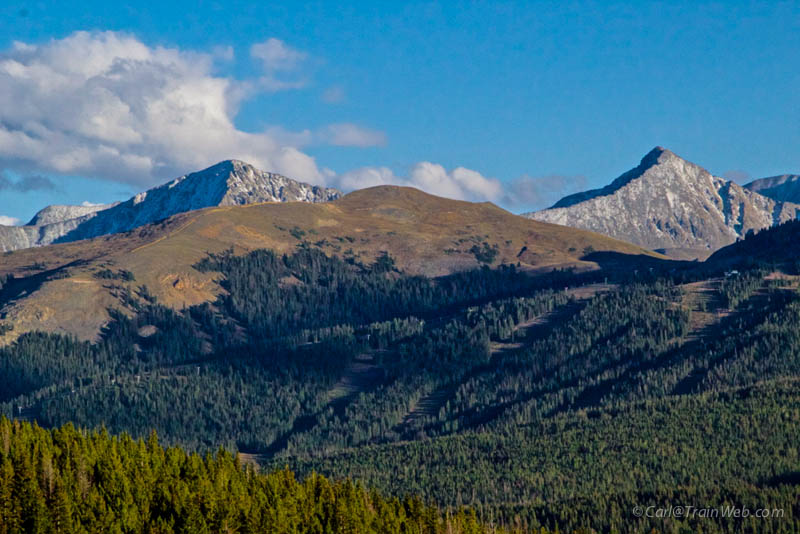
Georgetown Loop Railroad
After sunset, we made a quick stop at the Georgetown Loop
Railroad. I was surprised to find No. 9 still breathing and the
property unfenced allowing me to take some photos. I had heard of
this tourist railroad, but had never stopped. This railroad is
now definitely on my list for a future visit and hotel stay nearby.

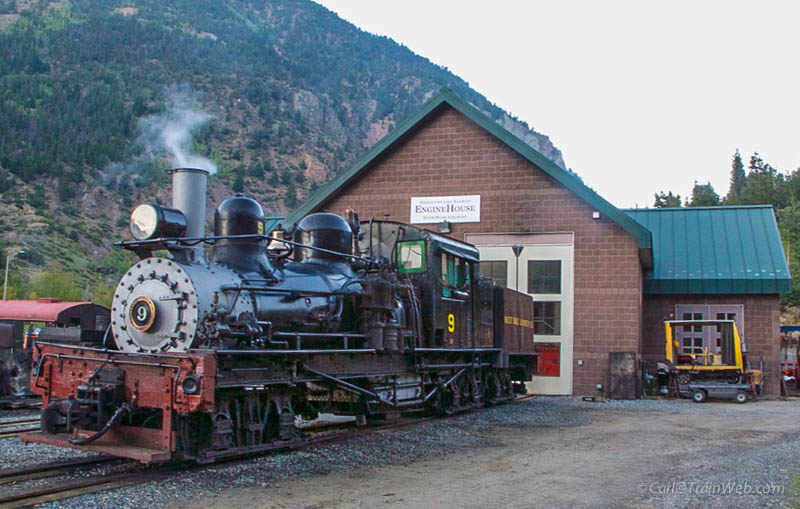
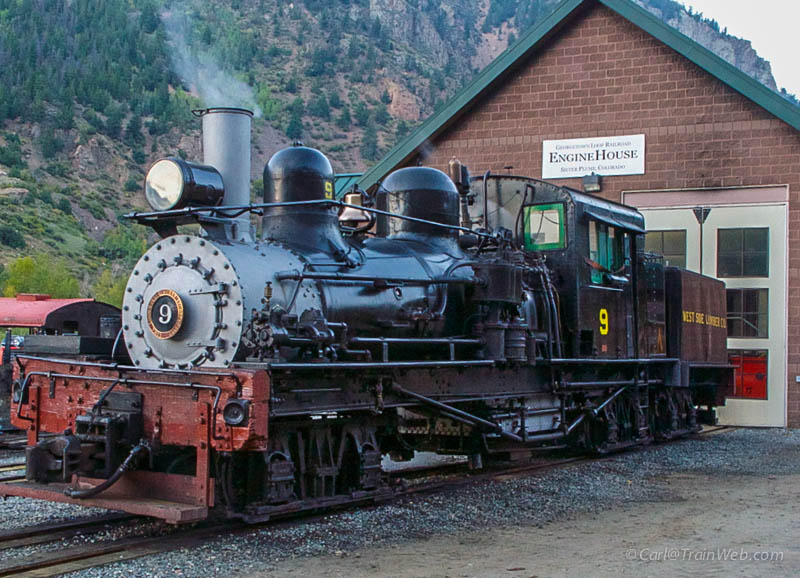



Idaho Springs
A few miles farther down the mountain we stopped in Idaho Springs for supper at a Beau Jo's pizza parlor.
The City of Idaho Springs is a
municipality in the U.S. state of Colorado that is the most populous
settlement in Clear Creek County, Colorado. Idaho Springs is located in
Clear Creek Canyon, in the mountains upstream from Golden, some thirty
miles west of Denver. Local legend is that the name of the city derived
from annual visits to the radium hot springs made by an "Indian"
(Native American) chief and his tribe who journeyed there each year
from Idaho to bathe in the magic healing waters.
Founded in 1859 by prospectors during
the early days of the Pike's Peak Gold Rush, the town was at the center
of the region's mining district throughout the late nineteenth century.
The Argo Tunnel drained and provided access to many lodes of ore
between Idaho Springs and Central City. During the late twentieth
century, the town evolved into a tourist center along U.S. Highway 6
and U.S. Highway 40, which ascend Clear Creek Canyon through the
historic mining district.
The town today is squeezed along the
north side of Interstate 70, with a historical downtown on its western
end and a strip of tourist-related businesses on its eastern end. It
also serves as a bedroom community for workers at the Loveland Ski Area
farther up the canyon. The town today is the largest community in Clear
Creek County, but, for historical reasons, the county seat has remained
at Georgetown.
--From http://en.wikipedia.org/wiki/Idaho_Springs,_Colorado
 Downtown Idaho Springs
Downtown Idaho Springs
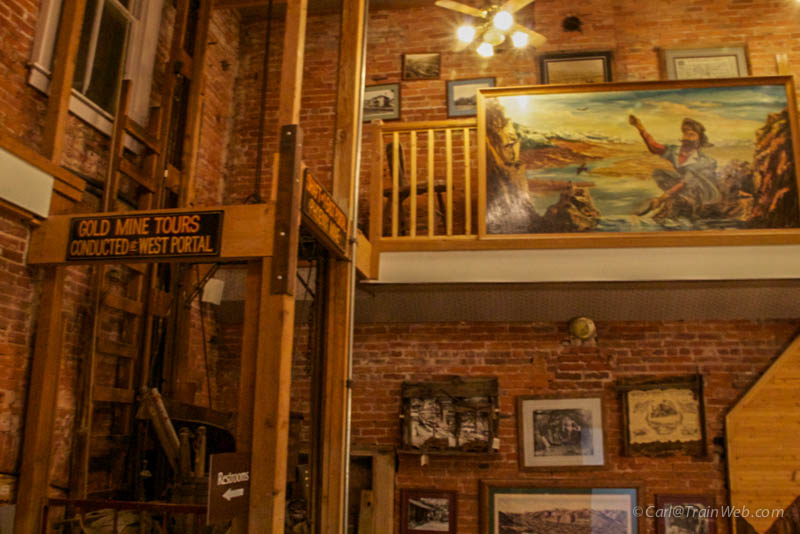
We ordered a 16 inch pizza.
However, as it turned out it was more 'rolled edge' dough than
ingredients. They call it, "Our
Mountain Pie is The Legendary Colorado Style Pizza! A pie topped with
mountains of ingredients and our hand rolled edge. Any
leftover crust can be covered with honey and eaten as a dessert!" Not what I had in mind.
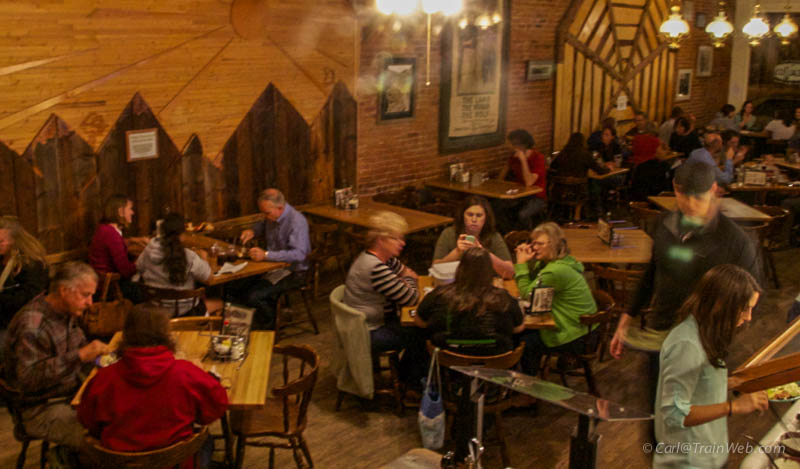



California Zephyr - Sacramento to Glenwood Springs, Colorado, almost.
I like to take a one-zone
Amtrak trip each year in a roomette using 15,000 Amtrak Guest Rewards
points one way. My travel buddy, Don Roe, uses his AGR points for
the opposite way. This year we told the AGR agent we wanted to go
from Fullerton, California to Glenwood Springs, Colorado. We had
been told that, since the Coast Starlight from Los Angeles does not
arrive in Emeryville soon enough to meet the eastbound California
Zephyr, we would need to stay overnight in Emeryville. We were
willing to do this. Don tried 4 different calls to Amtrak Guest
Rewards to make such arrangements, but instead we were forced to take
an Amtrak Surfliner from Fullerton to Los Angeles, a bus to
Bakersfield, California, a California Amtrak train to Stockton, and
finally a bus to Sacramento, where we still had to stay overnight to
meet the California Zephyr the next day. Two train Rides and two
bus rides to get to Sacramento seems unreasonable since the Coast
Starlight goes from Los Angeles to Sacramento.
I had already made the return reservations which was the California
Zephyr from Glenwood Springs to Emeryville, California, overnight in
Emeryville, then the Coast Starlight back to Los Angeles, and a
Surfliner the last 30 miles to Fullerton. In fact, when I made
these reservations, the experienced AGR agent said, "I see that you
know the drill." (Then why didn't the 4 agents Don talked with
"know the drill"?)
After our two buses and two trains to get to Sacramento, we checked
into the Vagabond Inn. Many train travelers stay at the Vagabond
between the California Zephyr and the Coast Starlight (and people like
us who took the multi-vehicle trip). Always when I stayed at the
Vagabond Inn before, to walk from the Sacramento Station to the Inn
meant walking two blocks to get across the street from the station
where the Inn is located. This time, however, there has been a
pedestrian crosswalk installed so one can walk out the front door of
the station then directly across the street to the Inn...no need for
the long walk or a short cab ride if you a not able to walk that far.
A Denny's used to be next to the Vagabond Inn, but it is now a Perko's, which is a northern California company.
We had dinner here and the quality was about the same as Denny's.
The Vagabond Inn offers a breakfast for guests so no need to go to
Perko's. A 20% discount is given to Vagabond Inn guests - ask at the hotel desk how to get this discount.

The Vagabond Inn now provides free shuttle service to the train
station. Since our bags were quite heavy, we decided to have the
driver take us to the station.
If you have a train leaving very early, however, check at the desk if
the shuttle "is running" at that time. Many times hotel shuttles
are piloted by an 8 to 5 hotel employee so it might not be available when you need it.
 The former Southern Pacific Station is being remodeled, so no
photos worth taking inside. The Starbucks on the southwest corner of the
station is still there.
The former Southern Pacific Station is being remodeled, so no
photos worth taking inside. The Starbucks on the southwest corner of the
station is still there.
 One portion of the remodel was to straighten the track past the
station. This meant that it is now a longer walk because the
platform is much farther away than before.
One portion of the remodel was to straighten the track past the
station. This meant that it is now a longer walk because the
platform is much farther away than before.
This Sacramento Business Journal writer posted this report more
than a year earlier than out trip, but it has several interesting facts
about the remodel project:
Aug 9, 2012, 11:26pm PDT Updated: Aug 10, 2012, 3:05pm PDT
Rail project hits mile marker with passenger platforms, track relocation starting on Monday.
Melanie Turner
Staff Writer- Sacramento Business Journal
Email | Twitter | Facebook
Passengers boarding Amtrak and Capitol Corridor trains at Sacramento Valley Station on Monday will depart from new passenger platforms a block and a half north of the existing platforms.
While it is still an active
construction site, the completion of the majority of the track
relocation project signals big progress in a $41 million project
intended to improve passenger safety and efficiency of train operations
— and makes room for the city’s future intermodal transit facility that
will allow passengers to transfer between Amtrak trains and Sacramento
Regional Transit District buses and light rail.
The project also aims to connect the
transit station and downtown grid to a planned future cultural and
entertainment district in the historic downtown rail yard. The 244-acre
redevelopment project is often touted as the country’s largest.
While financing is still a big hurdle for that project, first steps are moving ahead to establish necessary infrastructure.
The new tracks, two tunnels, a water
transmission line and new passenger platforms were built under a $41
million city contract with Granite Construction Inc. of Watsonville.
The 4-year-old project went out to bid twice before construction began in May 2011.
In moving four lines of track about 500 feet north of existing tracks and platforms,
contractors have replaced more than a half-mile of track and
straightened the track alignment to help trains move through the area
more efficiently.
There are now four passenger lines, instead of two, surrounded by two freight lines.
Two bridges over the new railroad
tracks and two of three planned tunnels are finished. A pedestrian and
bicycle tunnel, connecting Old Sacramento with the planned Central
Shops in the Rail yards, and two railroad museums, is on track to be
completed next spring. Work is set to begin in mid-September.
Meanwhile, the new passenger
facilities just north of Sacramento Valley Station at Third and I
streets are set to open with a 5:30 a.m. train Monday.
For now, a temporary asphalt path leads from the station into a central passenger tunnel connecting to the platforms.
A more permanent, covered walkway out
to the tunnel is expected to be completed in the next six to eight
weeks, said Hank Doll, construction manager with Vali Cooper &
Associates.
Leading into the tunnel, passenger
will find benches, a water fountain, a ticketing machine and a customer
service desk. Landscaping will come later.
The tunnel itself features LED lights and brick accents to match the central depot.
“We put a lot of effort and thought
into trying to make this a passenger place,” said city senior architect
Hinda Chandler, standing in a vestibule where arches over ramps and
stairways lead passengers up to platforms.
The platforms are equipped with giant fuel pumps for the trains. Historically, fuel trucks have been used.
“Now you’ll just see a truck once in a while,” Doll said.
In another move to cut down on
greenhouse gas emissions, a unique partnership between the Capitol
Corridor Joint Powers Authority and the Sacramento Metropolitan Air
Quality Management District means trains that now idle, spewing diesel
fumes during routine cleaning of their interiors, will have lights,
heat and air conditioning powered by electricity instead. State grant
money helped pay for eight clean-power units.
And while the platforms are a short
walk from the main station, there will a “red cap service” for people,
such as the elderly, who request assistance. Eight trams, similar to
large golf carts, will be available to escort people, said Vernae
Graham, an Amtrak media relations manager. Two carts have the capacity
to carry 15 people each and six others can carry seven people apiece.
Luna Salaver, a spokeswoman for the
Capitol Corridor Joint Power Authority, said Capitol Corridor is
particularly pleased that passengers will have a safe way to get
between the train station and the tracks. Today, passengers looking to
catch a train walk, in some cases, “at grade” across the tracks, she
said.
Capitol Corridor, she said, is encouraging people to allow extra time to walk the additional 500 feet.
Funding for the project has come
mainly from federal stimulus programs and state Proposition 1B and 1C,
which voters approved in 2006.
Representatives of the city of
Sacramento, Amtrak, Capitol Corridor and the California Department of
Transportation hosted members of the media on a tour of the facilities
Thursday.

Notice how the long walk ends - it
drops into a tunnel so passengers can get under the tracks and up
another ramp to get to the platform. This provides for safe
passage of riders so they do not have to cross any tracks. If
you feel tired dragging your bag all this distance, you have the two
elevations to navigate. Hint: take the "people mover" (cart) out
to the train with your carry on luggage. The light rail still has its platform closer to the station (above).

 I walked to the head end and spotted the fueling station mentioned in the article.
I walked to the head end and spotted the fueling station mentioned in the article.
 So, a full day after we left home, we were in Sacramento and on the California Zephyr headed east to Glenwood Springs, Colorado.
So, a full day after we left home, we were in Sacramento and on the California Zephyr headed east to Glenwood Springs, Colorado.
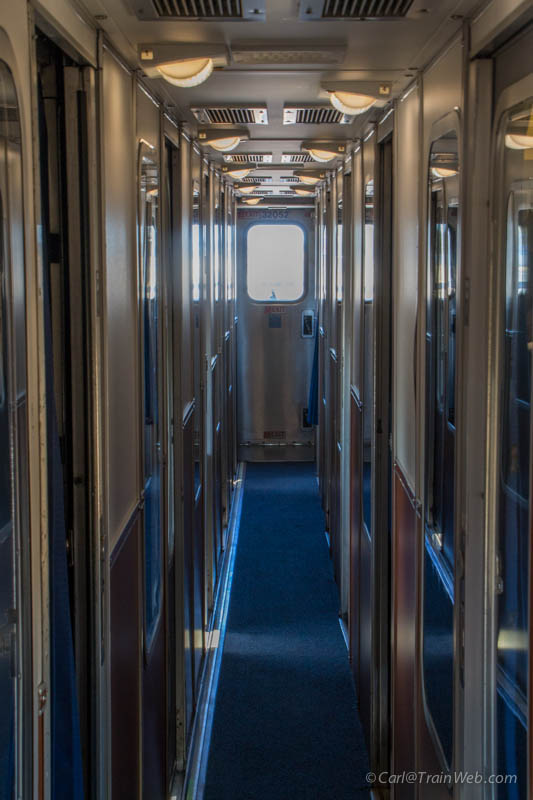
I like to travel in an upstairs
room. Traffic through the car to the diner and sightseer lounge is on
the upper level, so no stairs must be navigated if you have an upstairs room. On the
California Zephyr, the sleeper cars are on the rear of the train,
unlike the Southwest Chief. Our sleeper car happened to be the
last car on the train, so I could venture to the end of our car and see
down the tracks out the back door.
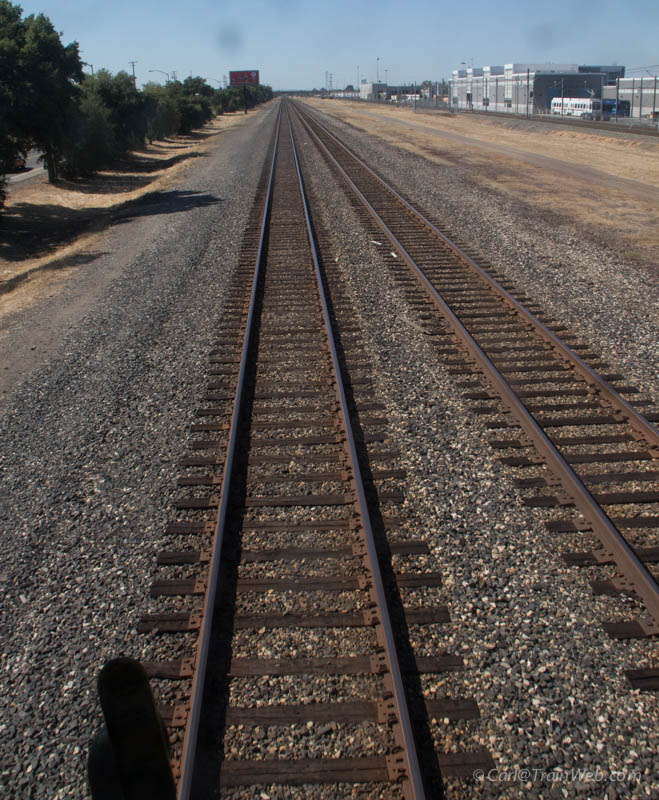
The Sightseer/Lounge Car was a remodeled version with half tables and half seats facing the windows. Don
always likes to spend time at one of the tables to do his professional
reading, and I like the tables, each with electrical outlets, to use my
laptop for editing trip photos.
Since it was the beginning of the trip, and I had no photos to edit, I read Henry Kisor's current eBook novel, "Hang Fire" on my iPad. I first learned of Henry through his book, Zephyr - Tracking a Dream Across America which is about this very train. After reading Zephyr,
I learned of his murder mysteries and have enjoyed each of them.
A train ride is a great place to read. From your reading, you can
look up at any moment and watch the world go by.



An announcement came over the all-train
public address system inviting passengers to the Sightseer/Lounge car
to hear volunteers from the California State Railroad Museum in
Sacramento give a commentary about the history of this route. I
know a Trails & Rails coordinator and route guide author, Robert
Tabern, who works with the Empire Builder and the Southwest Chief.
California State Railroad Museum volunteer, Al Gallardo, above, said
that from 1865 on, there were up to 10,000 Chinese who worked on the
Central Pacific Railroad. When the transcon was completed, they
moved on to other railroad construction projects in the US.
Trails & Rails Program
Heritage Appreciation during Your Train Ride Trails & Rails Logo
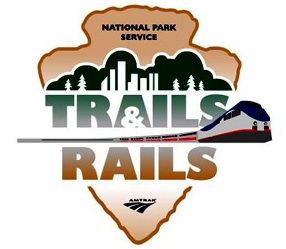 Trails
& Rails is an innovative partnership program between the National
Park Service and Amtrak, providing rail passengers with educational
opportunities that foster an appreciation of a selected region's
natural and cultural heritage. It also renews the long tradition of
connecting railroads with National Parks.
Trails
& Rails is an innovative partnership program between the National
Park Service and Amtrak, providing rail passengers with educational
opportunities that foster an appreciation of a selected region's
natural and cultural heritage. It also renews the long tradition of
connecting railroads with National Parks.
Since the beginning of the 20th century, railroads played an active
role in developing America's national parks, encouraging vacationers
and long-distance travelers to take the train to these highly
sought-after destinations.
Through the program, Amtrak passengers can connect to public lands and
engage in a better understanding of the need to preserve and protect
these special natural and cultural resources. As an example of this
philosophy of stewardship in action, rail travel to parks and protected
areas provides a fuel efficient and environmentally friendly way to
visit public lands.

When California State Railroad Museum volunteer, Mas Hatano, took over
the microphone, we were looking down the American River Valley 1500 ft.
below. The American River runs through Sacramento. I talked
with Mas about his volunteering at the California State Railroad Musuem
and he said, "All you have to know to work there is where the restroom
is."

Soon we were passing the Roseville, California, Union Pacific rail yards and maintenance facility.

When passing the Roseville Yard, I
always look for the rotary stored here for snow removal in the Sierra
in the winter. Mas pointed out a "baloon track" (not a Wye) for
turning the snowplows.
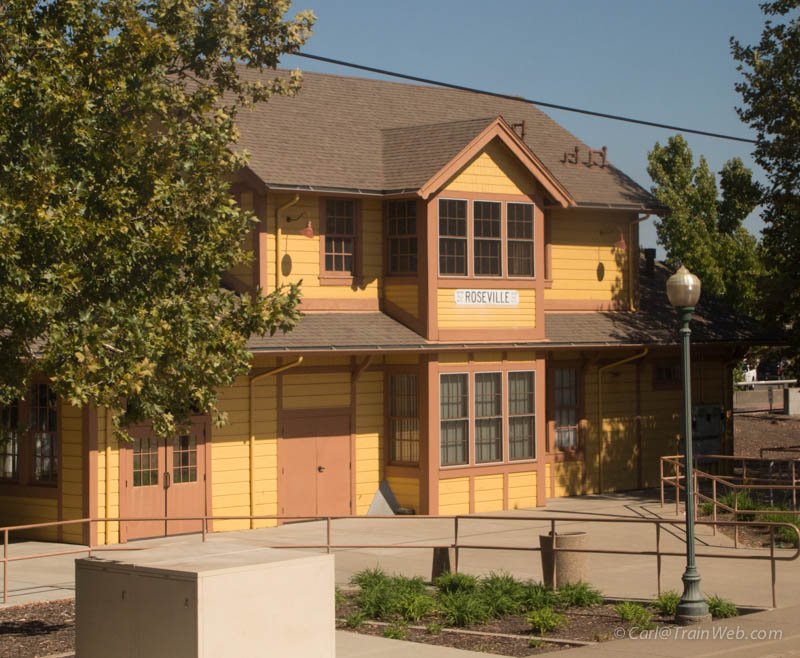

 This Sightseer/Lounge passenger was well outfitted with his sketch book, tunes, drumsticks, and camera.
This Sightseer/Lounge passenger was well outfitted with his sketch book, tunes, drumsticks, and camera.
 The alternative route through the Sierra from Sacramento through Reno and beyond is I-80.
The alternative route through the Sierra from Sacramento through Reno and beyond is I-80.
 I like the vintage station signs giving essential facts about the historic route.
I like the vintage station signs giving essential facts about the historic route.

 Fall colors were developing even though it was mid September.
Fall colors were developing even though it was mid September.
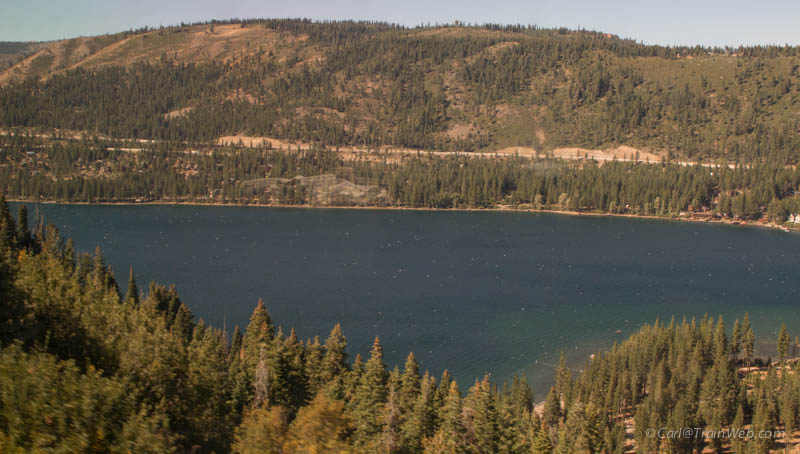 Donner Lake and I-80 above Truckee, California.
Donner Lake and I-80 above Truckee, California.
About this time of day it was "Last
Call" for lunch. We made our way to the Diner. When you
have a room on an Amtrak train it includes 3 meals a day. Menu
prices are quite high for coach passengers in my opinion. There
is a cafe on the lower level of the Sightseer/Lounge car where ala
carte items are sold. Prices are still high, so many short
distance coach passengers bring their own food and drink to be enjoyed
in the Sightseer car or their coach seat with tray table. For
this lunch I selected the angus burger with chips and blood-orange
sorbet.
 On my way back to my room, I ventured a few more feet to the back window for this shot.
On my way back to my room, I ventured a few more feet to the back window for this shot.

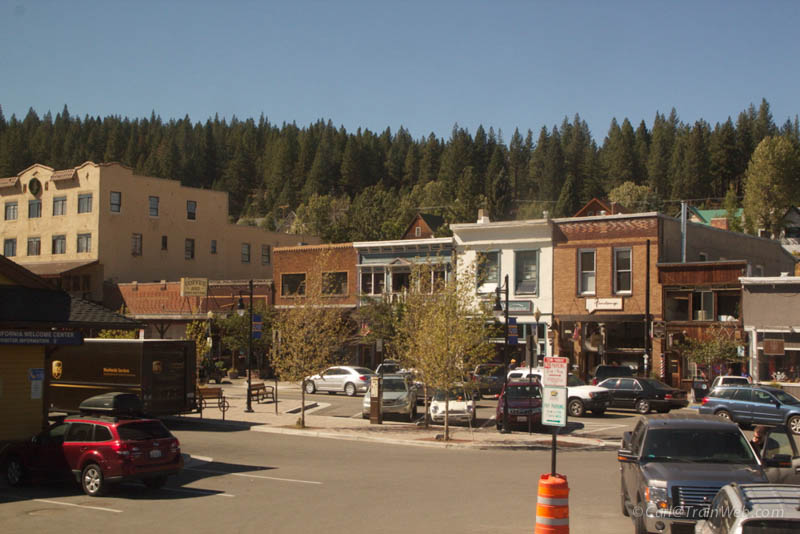
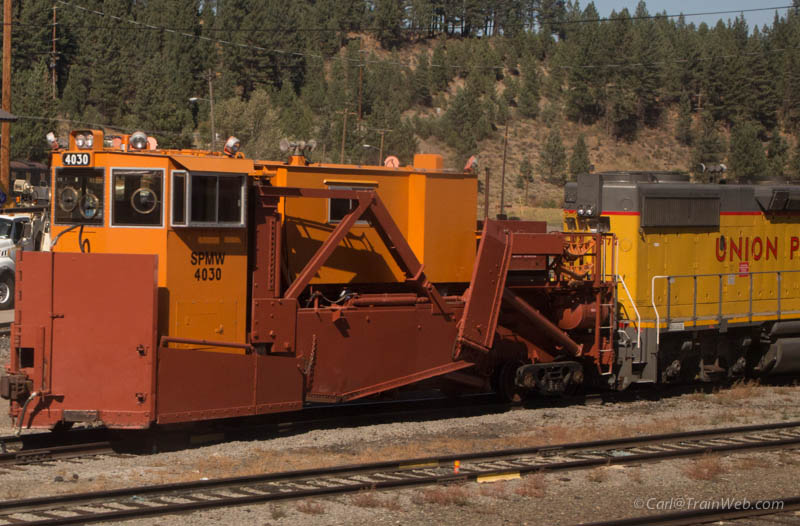 Another form of snow handling equipment awaits winter in Truckee.
Another form of snow handling equipment awaits winter in Truckee.
 I like the view from the Zephyr down the Truckee River toward Reno, Nevada.
I like the view from the Zephyr down the Truckee River toward Reno, Nevada.
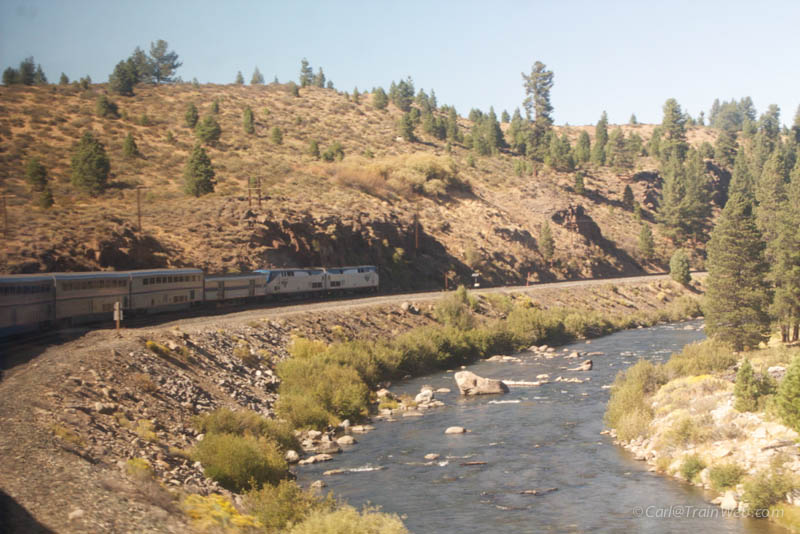
With the slow, sharp curves, you can get a nice photo of the front half of the train beside the river.


Several unused, one-lane or
single-track steel bridges cross the river along the way. Because
of the sharp turns on both ends, I presume it was a former highway
bridge. It looks like it is now a nice bike or hiking trail.
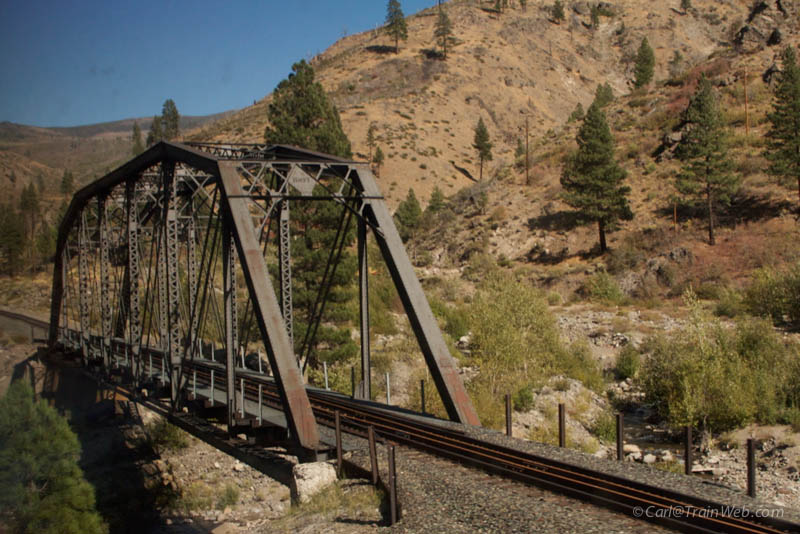 This single-track steel bridge was on the second track alignment and still in use as we passed on a newer bridge.
This single-track steel bridge was on the second track alignment and still in use as we passed on a newer bridge.
 A dam holds back water (above) so it can be diverted into an acquaduct (below).
A dam holds back water (above) so it can be diverted into an acquaduct (below).

 We again cross the Truckee river with a view of the aquaduct
and a railroad bridge from the second rail line down the mountain.
We again cross the Truckee river with a view of the aquaduct
and a railroad bridge from the second rail line down the mountain.
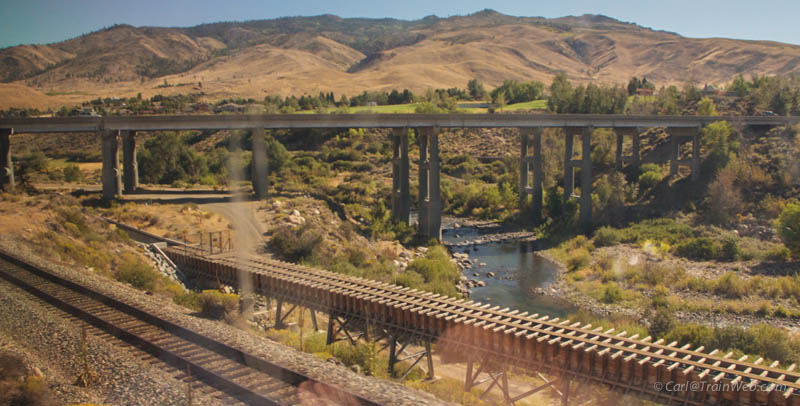 Railways, waterways, and highways heading down the mountain.
Railways, waterways, and highways heading down the mountain.
 A large vintage barn from an earlier era.
A large vintage barn from an earlier era.
 This large resort, with the river directly behind it, seems to be a victim of low occupancy.
This large resort, with the river directly behind it, seems to be a victim of low occupancy.
 The Reno stop is now below street level and does not block the many streets in downtown Reno.
The Reno stop is now below street level and does not block the many streets in downtown Reno.
 Reno is a change of crew stop which usually also means a stretch and smoke stop.
Reno is a change of crew stop which usually also means a stretch and smoke stop.
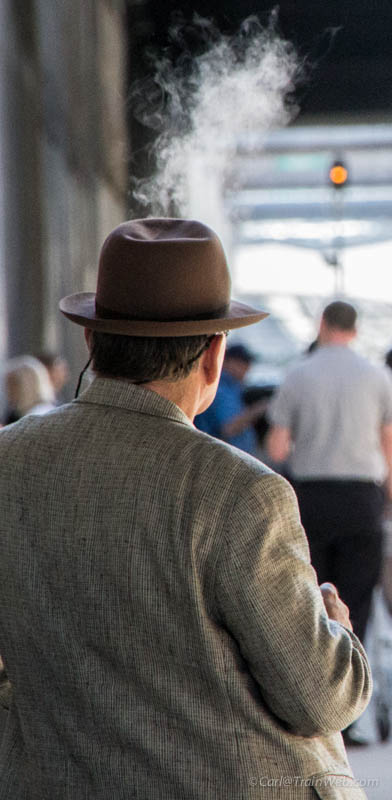 I thought this passenger was dressed as if he was riding the original Zephyr.
I thought this passenger was dressed as if he was riding the original Zephyr.
 Inside the Reno Station are many historic photos at track level.
Inside the Reno Station are many historic photos at track level.

The 1910 Johnson-Jeffries Train with two 2-8-0 engines bringing passengers from California to the "Fight of the Century".
 City of San Francisco, 1936.
City of San Francisco, 1936.
 Rising up out of Reno, a view from the last Amtrak car.
Rising up out of Reno, a view from the last Amtrak car.


Sparks, Nevada (above), used to be
a crew change station. Now the crew changes in Reno. Our
train traveled slowly through Sparks, past the Nugget Hotel, separated from the tower by a container train.
 The conductor pointed out wild mustangs along the way east of Reno.
The conductor pointed out wild mustangs along the way east of Reno.
 Typical high desert scenery between Reno and Winnemucca, Nevada.
Typical high desert scenery between Reno and Winnemucca, Nevada.
 Winnemucca, Nevada, at Sunset. New, large platform for the two Amtrak trains a day.
Winnemucca, Nevada, at Sunset. New, large platform for the two Amtrak trains a day.

 Last shot of the day at Winnemucca, but dinner still awaits in the diner.
Last shot of the day at Winnemucca, but dinner still awaits in the diner.
I had salmon, vegetables, rice, with Sierra Mist to drink with Tahitian Vanilla Bean Gelato for
dessert. We turned our clocks ahead one hour
before bed at 9/10 p.m. I had a nice night watching the full moon
from
my lower berth on the California Zephyr. Up at 7 for a shower and
breakfast of vegetable omelet, raisin bread toast, decaf and OJ.

 Although the west flowing Colorado River was muddy and full,
rafters were arising from camping for the night on the shore as we
passed.
Although the west flowing Colorado River was muddy and full,
rafters were arising from camping for the night on the shore as we
passed.
We learned that we would be
transferred to buses in Grand Junction because of track washouts between Glenwood Springs
and Denver. We had heard in Sacramento that this might
happen. Even earlier information had led us to believe that our
train would terminate in Glenwood Springs and those with destination
stations beyond would be bussed. The final decision was to bus
those with destinations beyond Grand Junction, which included us going
to Glenwood Springs. We boarded the appropriate bus for the ride
from Grand Junction to Glenwood Springs.
The LSA said the rumor was that the California Zephyr, westbound,
would begin a reroute the next day from Denver through southern Wyoming
to Salt Lake City, Utah where it would follow the usual route to
California. Therefore, we would be bussed to Salt Lake City if
this was true. Don immediately began thinking of getting us to
Denver so we could take the reroute through Wyoming rather than that
awfully long bus ride.
 There were three buses and a bit of confusion, however all
passengers got on the correct bus before any departed from Grand
Junction.
There were three buses and a bit of confusion, however all
passengers got on the correct bus before any departed from Grand
Junction.

Our bus arrived in Glenwood Springs
in good time after a shower during the trip. This photo was taken
from the front door of the Hotel Denver, just across the street from
the Amtrak Station.
For photos in Glenwood Springs and Aspen, return to the Table of Contents above and start reading there.
California Zephyr - Glenwood Springs to Emeryville, California on a rare Wyoming reroute.
There were track washouts between Glenwood Springs and Denver and
Amtrak had announced that the westbound California Zephyr would detour
at Denver through southern Wyoming to Salt Lake City. Those
passengers holding tickets to board between Denver and Salt Lake City
would be bussed to meet the train in Salt Lake. During the day
before our scheduled return, we called Amtrak Guest Rewards and had
them change our tickets to board the westbound California Zephyr in
Denver, thus avoiding the bus ride.
We canceled our second night reservation at the Hotel Denver and Don's
friend, who had come over from Denver to take us to Aspen for the day,
agreed to take us back to Denver so we could meet the 8 a.m. westbound
California Zephyr in Denver the next morning. We stayed the night
at the Hampton Inn Cherry Creek Denver for $153. We called a cab
at 6:10 a.m. and arrived at the station before 7. At the station, we
learned that the train was 1:14 late. I took the time to walk,
which I had not been able to do while riding on the train. I
walked east then west of the temporary Denver Station.
Back at
the station, I met Quinn, a pipeline worker who travels by Amtrak,
staying in hotels each night. Now that I think of it, that would
be the most economical way to travel on Amtrak - purchasing a coach
seat and getting a hotel near the station and seeing the town for a day
before going on by coach.
Finally, the train arrived, we
boarded and began our journey from Denver toward Cheyenne then westward
toward California.
 Temporary Amtrak Station in Denver, Colorado
Temporary Amtrak Station in Denver, Colorado
The Ticket Agents at Denver handed
out "ReRoute Guides" for the Wyoming trip. I received the same
guide in 2004 authored by "C. L. Katz 2004" a coach car attendant on
that trip. The guide was presented by Colorail P. O. Box 480452,
Denver, CO 80248 or www.colorail.org.
The following information is full sized, so it may take some mousing to read it all, but it should be large enough to read.



 What you can see within walking distance from the temporary Denver Amtrak Station:
What you can see within walking distance from the temporary Denver Amtrak Station:
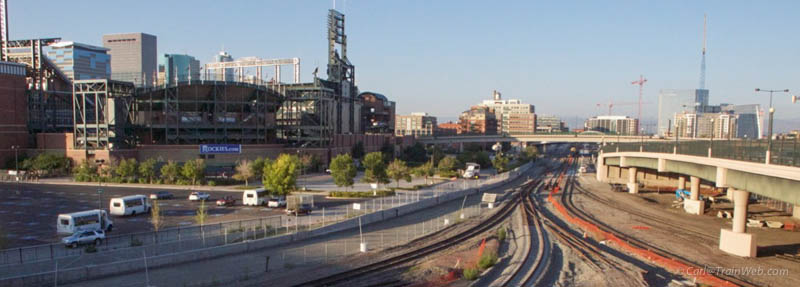 Denver Rockies Stadium (left). Old Station and temporary station under farthest bridge.
Denver Rockies Stadium (left). Old Station and temporary station under farthest bridge.
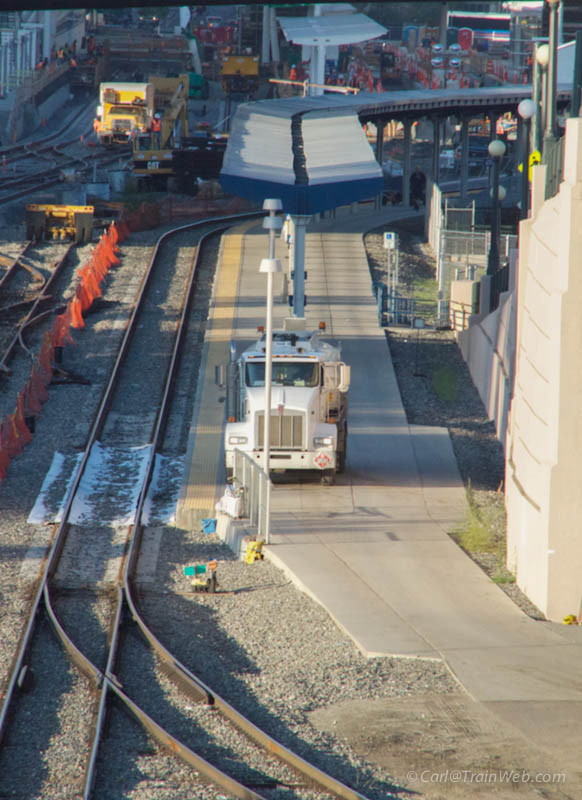
Fueling truck awaiting the Zephyr's
arrival which will back into the station. Curved temporary track
and platform cover. White cover beyond is new platform when track
continues straight past the remodeled station.
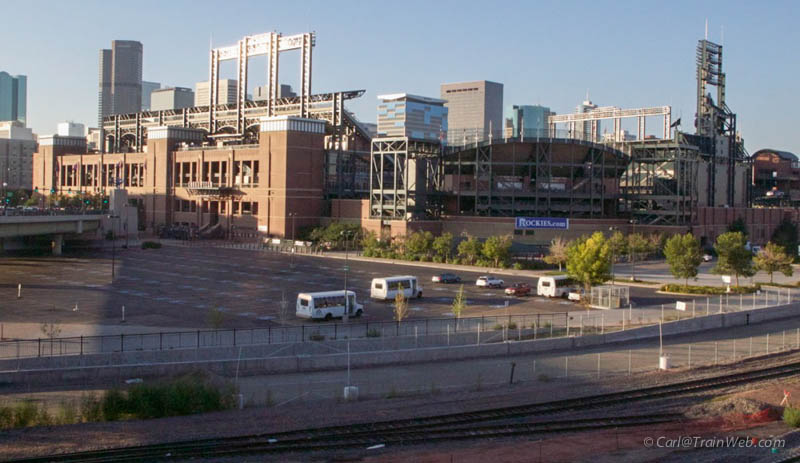 Rockies Stadium and downtown Denver beyond.
Rockies Stadium and downtown Denver beyond.
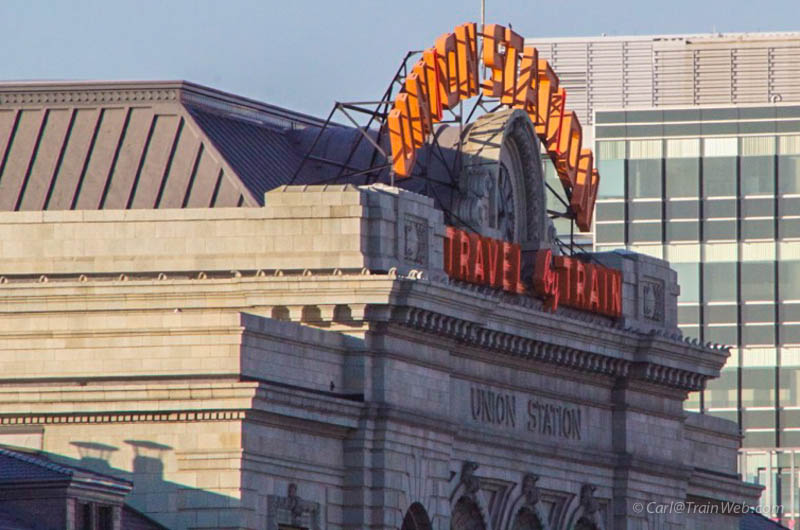 Denver Station, trackside, currently being remodeled.
Denver Station, trackside, currently being remodeled.
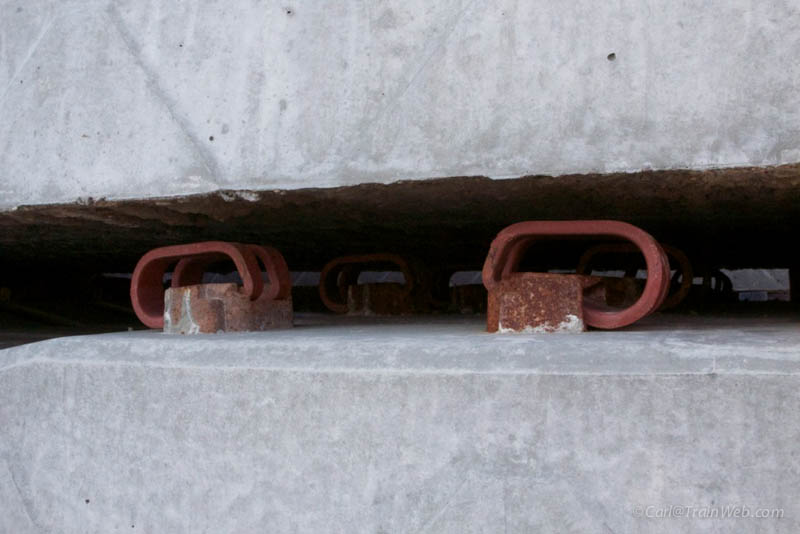 While walking before our train arrived, I found a stack of new
concrete cross ties. I use this photo to show how rails are
clipped to the concrete ties.
While walking before our train arrived, I found a stack of new
concrete cross ties. I use this photo to show how rails are
clipped to the concrete ties.
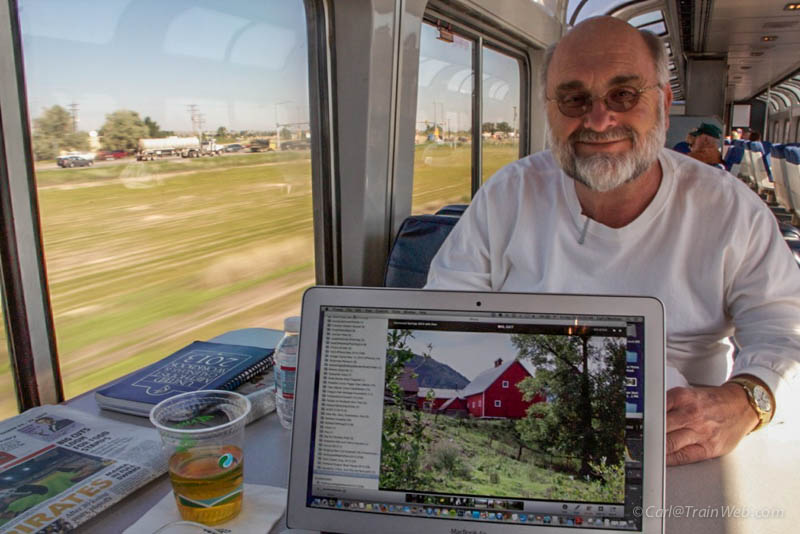
Traveling pardoner, Don Roe, doing
his professional reading in the Sightseer/Lounge car as I edit photos
taken at St. Benedict's Monastery while we speed north from Denver to
Wyoming. Drinks and newspaper from our sleeper car attendant, Johnny.

Hand picked tomatoes north of Denver. These
tomatoes will probably end up in the produce section of the grocery
rather than machine-picked salsa and ketchup tomatoes. This
is the first day of the reroute, so workers along the railroad have a
shiny Amtrak train to watch go by for a change.

We noticed that the highway
parallel to our tracks was slowed to one lane across this river.
We also knew that this rail route had been closed the previous days
perhaps because of the need to inspect for damage to the bridge we were riding on at the
moment. You can see that the water had receded from a previous
high mark.
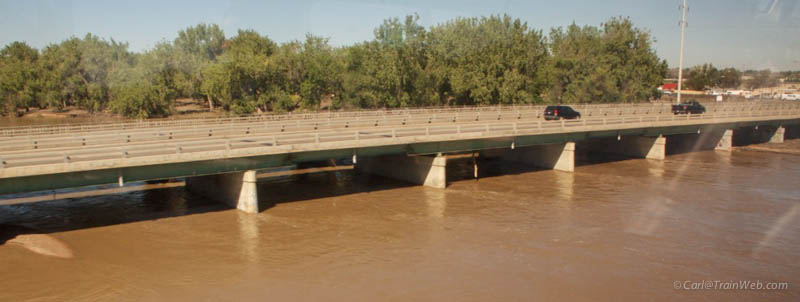
 These workers at a grain milling operation along the railroad seemed surprised to see an Amtrak train on this track.
These workers at a grain milling operation along the railroad seemed surprised to see an Amtrak train on this track.

The western plains states have many
vintage windmills in the large pasture lands. This one, near the
Colorado/Wyoming border, is still operational pumping water up
from a well into a tank for the range beef cattle using
wind power rather than electricity. The U-shaped device to the
right is an oil-soaked scratching pad that cattle can rub against and
walk under for relief from pesky flies. Dairy cattle do not
have such large pastures and are brought to the barn morning and
evening for milking when the milkers apply fly spray.
 The conductor announced the approaching large bison herd on the right side of the train.
The conductor announced the approaching large bison herd on the right side of the train. It was the Blue Mountain Bison Ranch, P.O. Box 1460 Lyons, CO 80540.
Blue Mountain Bison is a Bison
ranch located in the foothills of Colorado. With five thousand acres of
rugged terrain including open fields of mountain grass, aspen,
ponderosa pine and the north fork of the Little Thompson river, Blue
Mountain Bison is a picture perfect place for buffalo to roam, just an
hour north of Denver and 15 miles west of interstate I-25. The
Plains bison of today is making a welcome comeback. There are over
250,000 bison alive today from Mexico to Canada. Bison can be found in
all fifty states of the union. Over 95% of the bison alive today are
found on private ranches raised for breeding stock, meat and
by-products.
Bison or as they are also known, buffalo, have long been a symbol of
the old American west. A symbol representing power, freedom and the
spirituality of nature You can find bison as team mascots, on a
ten-dollar bill, stamps, a nickel, two state seals and a 2000, 2003
special silver dollar U.S. mint coin.
The plains bison is found in North America, the woods bison is found in
Canada and the Wisent is found in Europe. The bison alive today
developed during the last ice age and made their way to North America
where they could be found from the East Coast to the West Coast. The
Native Americans of the west had a special relationship with the bison
herds, but all Native Americans utilized the bison.
There was an unchecked slaughter of bison in the late 18th century. As
people moved west the bison populations declined until there were no
bison left east of the Mississippi and as people headed to the new
frontier further west the populations were decimated. Bison were
considered undesirable because of their wild tendencies and their
awesome power. What could have turned into another dodo bird, instead
became a success story due to several individuals who made an effort to
preserve and protect the remaining animals. Many of the remaining
animals left in the wild were collected and put on either private
ranches, zoos or on preserves. Many of those preserves have turn into
national or state parks where the public can view bison. Bison are
making a comeback on private ranches and on reservations across North
America. There are twice as many buffalo today then there was just ten
years ago.
Bison Facts:
- Both Males and Females develop horns.
- Males can weigh over 2000lbs, [2,000
pounds = 1 ton] and stand over 7 ft tall. Bulls do not fully reach
their adult size till 5-6 years of age, although they can start
breeding as a yearling.
- Females are only half the size of males
and can weigh up to 1400lbs at only five and half feet tall. They reach
their adult size by 4-5 years of age, but will usually have their first
calf by 3.
- The females have one calf a year. Gestation is roughly 265 days.
- The calves are born orange in color and weigh around 40lbs.
- By the time the calves are yearlings they will weigh over 600lbs.
- Bison are wild animals even when found on private ranches.
- Bison are herd animals based on social groups usually related females.
- Bison Males are loners as they age
- Bison establish positions of rank by
fighting. Higher ranked animals get to lead, drink, and eat first when
moving from area to area.
- Bison Males will fight for the right to
breed although vocal and non-verbal clues- maybe enough to send a rival
running.
- Bison Males court one female at a time
and get so caught up in the courting they do not have enough time to
eat and will lose 10-20% of their body weight during the rut.
- Bison are great athletes- they can run
faster than a horse, jump higher than six feet and pivot on either
their hind legs or front legs.
- Healthy bison have no natural predators. Only weak and sick animals are vulnerable to natural predators.
- Bison can live to thirty.
--From www.bluemtnbison.com/
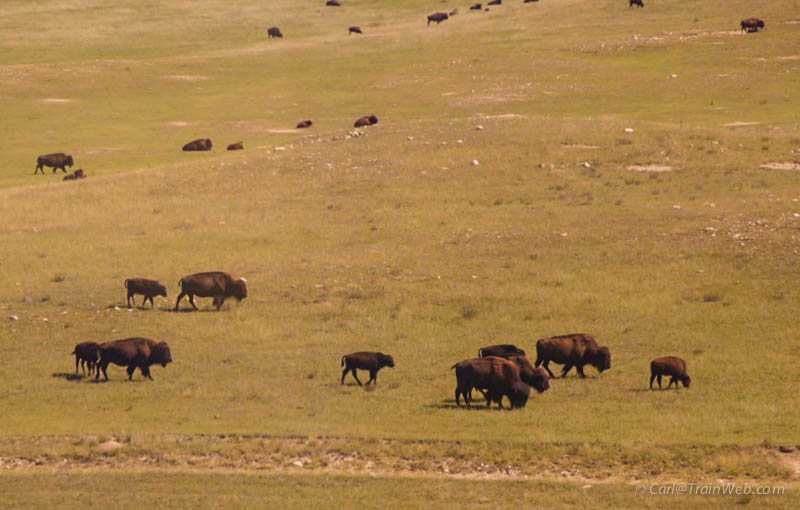

Once we turned westward in Wyoming,
a large load of rock passed our train. We wondered if it would be
used to replace some washed out railroad tracks in Colorado.
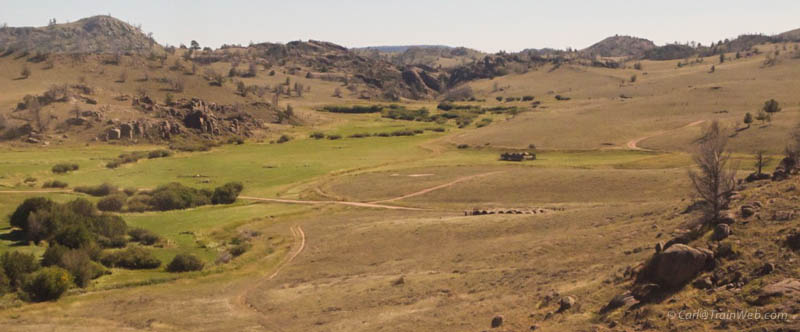
This group of rocks in a valley was a change from the typical scenery in southern Wyoming of high plains grasslands. Still "Big Sky Country".
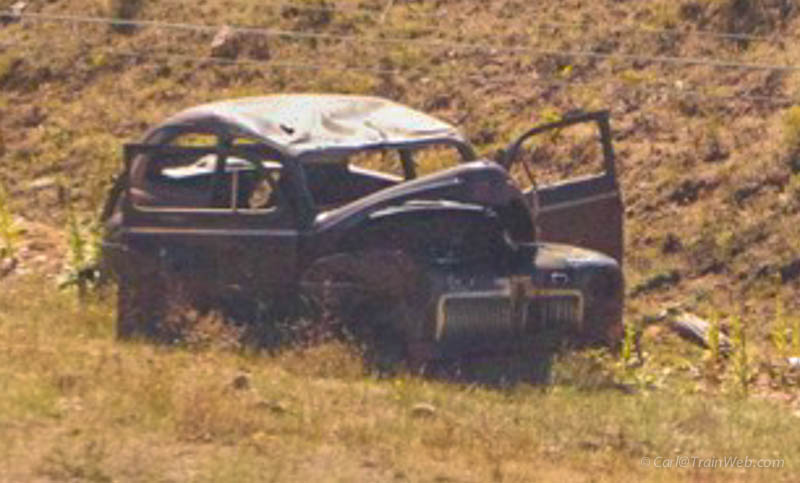

Most any train ride in the U.S.
will reveal rusty decades-old cars. Sometimes they are used to
control erosion, but the one above right was placed in some kind of
obstacle course.
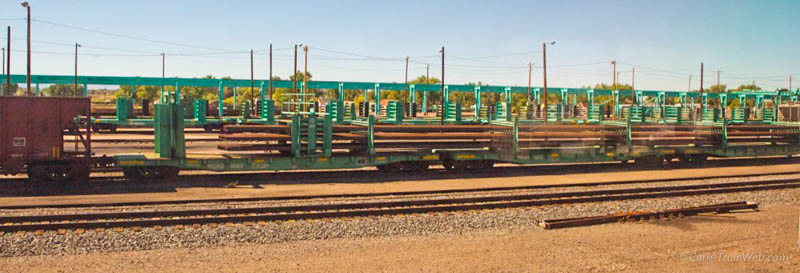
This was a ribbon-rail factory
producing 1/4-mile or longer sections of rail which are welded
together in a continuous, seamless rail. Each section of rail from this factory takes up several cars. The
only time you hear the 'clackety-clack' when riding the train nowadays is where
shorter sections are used for turnouts and signals.
 Another buffalo ranch. I do not believe the Blue Mountain
Ranch was large enough to include this property, but I do not know what
5,000 acres looks like.
Another buffalo ranch. I do not believe the Blue Mountain
Ranch was large enough to include this property, but I do not know what
5,000 acres looks like.
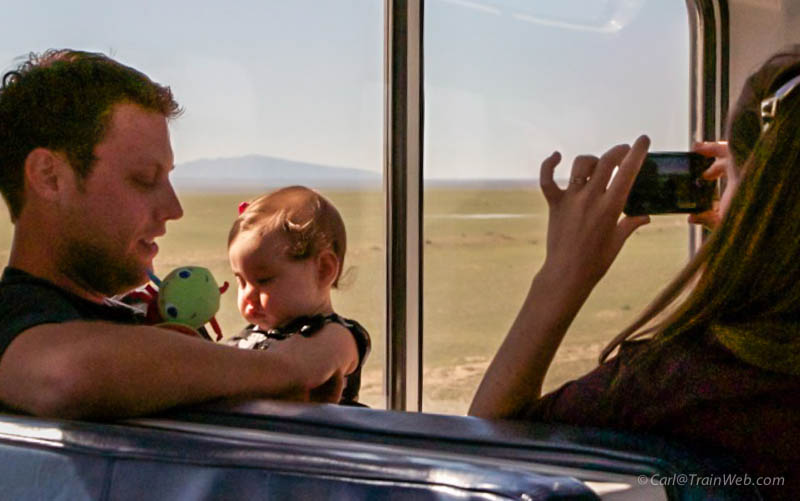
Back inside the sightseer/lounge
car, I could not help but notice the proud parents of this little
girl. This is the kind of family that can make the best use of a
Family Bedroom on the train.


All I could learn from Heward
Ranch's gate was that they raised Hereford beef cattle. Not why
they had such unusual haystacks like something one would see in Northern
Europe (below).

 Windmills of the 21st Century producing electricity rather than pumping water for cattle.
Windmills of the 21st Century producing electricity rather than pumping water for cattle.

I took this photo to show the Union
Pacific snow blower with red blades, but had noticed the giant drag
line mining crane peeking over the foothills at Hanna, Wyoming.
This is the Medicine Bow Mine Owner: Arch Coal
Inc. Location: Carbon County, Wyoming, six miles west of
Hanna, Wyoming on U.S. Highway 30 Rail Loading Point:
Hanna, Wyoming
 I have seen post cards showing houses like this with the title, "One more payment and it is mine all mine!"
I have seen post cards showing houses like this with the title, "One more payment and it is mine all mine!"
 This solitary building looks like an abandoned schoolhouse to me.
This solitary building looks like an abandoned schoolhouse to me.

One of the unused stations of the former Overland Route.
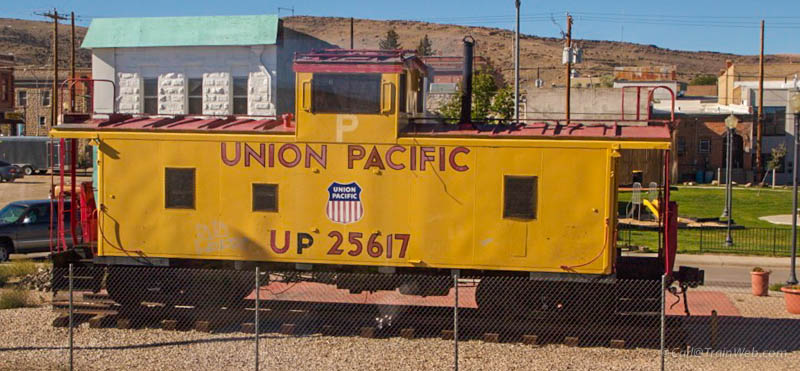

 As with most Amtrak trips, you will pass the sister train, headed in the opposite direction, once or twice during your trip.
As with most Amtrak trips, you will pass the sister train, headed in the opposite direction, once or twice during your trip.


In Salt Lake City, there was a crew
change giving me time to photograph the car in our consist being
delivered to the Oakland yard. I will probably see this car in
the future on my home route from LA to San Diego.
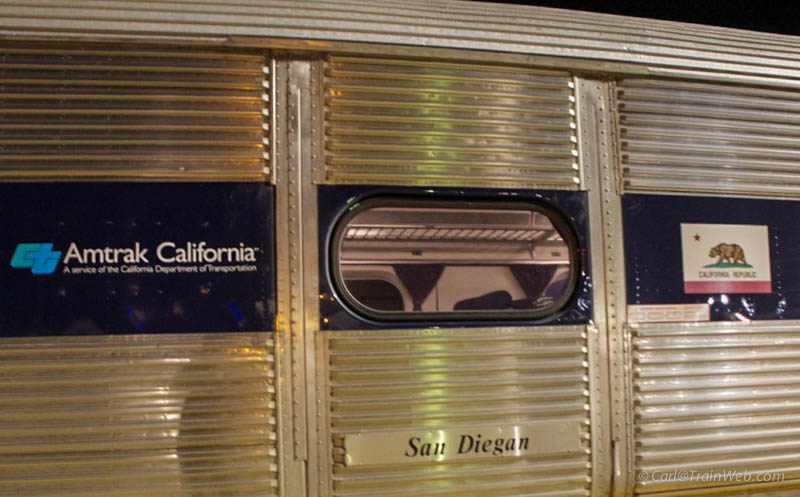

California Zephyr in Salt Lake
City, Utah, on September 20, 2013, after the first reroute from Denver
to skirt the track washout between Denver and Glenwood Springs,
Colorado.
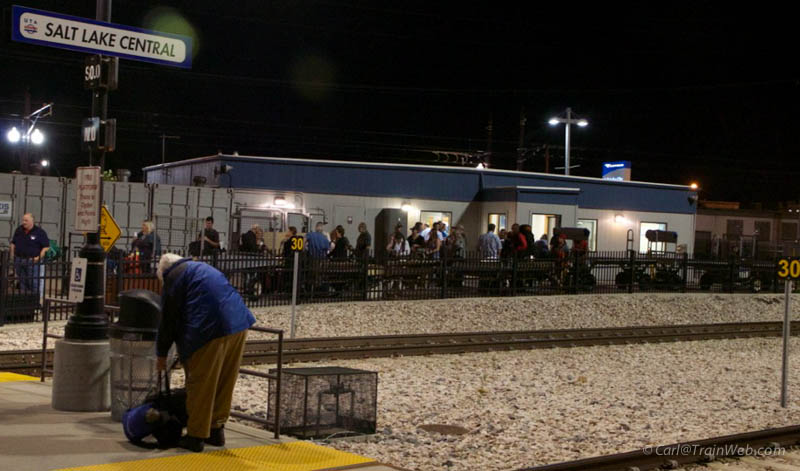 At the temporary Salt Lake City Amtrak Station, passengers have to cross active tracks between Amtrak trains and the station.
At the temporary Salt Lake City Amtrak Station, passengers have to cross active tracks between Amtrak trains and the station.
 The light rail, however, arrives on the far side of the station.
The light rail, however, arrives on the far side of the station.
 The following morning, we were back on the original route and
traveling along the Truckee River westward through the Sierra Mountains.
The following morning, we were back on the original route and
traveling along the Truckee River westward through the Sierra Mountains.
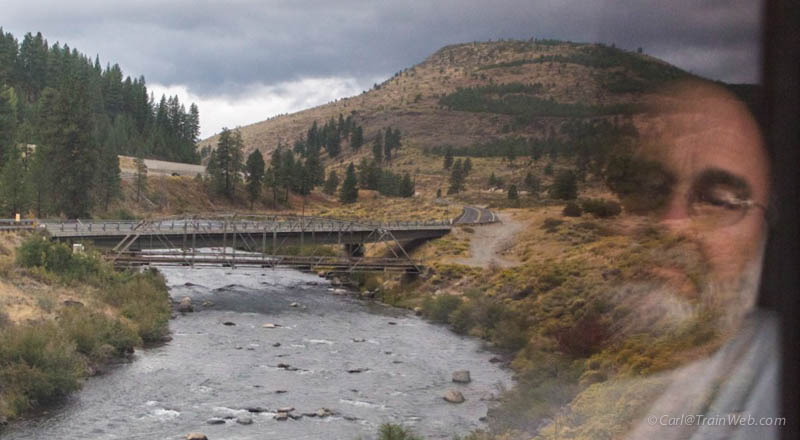 From our roomette, Don watched the Truckee River and the bridges across it as we climbed the mountains heading west.
From our roomette, Don watched the Truckee River and the bridges across it as we climbed the mountains heading west.

Fly fishing was in season in this 3rd week of September.
 Again, the slow curves allowed me to photograph the front of the train from our roomette.
Again, the slow curves allowed me to photograph the front of the train from our roomette.


 Truckee, California
Truckee, California
 This restored gas station in Truckee appears to now be a realty office.
This restored gas station in Truckee appears to now be a realty office.
 In rain showers, it is comforting to be on a train and leaving the
driving to Amtrak rather than driving on slick roads at 70 mph.
In rain showers, it is comforting to be on a train and leaving the
driving to Amtrak rather than driving on slick roads at 70 mph.
 Adding a second mainline in terrain like this, the tracks are
often separated enough so you can photograph tunnels on the adjacent track.
Adding a second mainline in terrain like this, the tracks are
often separated enough so you can photograph tunnels on the adjacent track.

Since the reroute resulted in a
less-than-full train, I asked our excellent car attendant, Johnny, if
he would rather make up two lower roomette beds than an upper and lower
bed in our roomette. He said he would know after Salt Lake
City. At that point he said another room was available for the night, so Don
and I both enjoyed the bigger, lower berth in our own roomette for the
night. Don gave Johnny a generous tip of course. Even after
breakfast, Johnny informed us that the roomette directly across from
ours was now available if we wanted to spend the rest of the day in our
own roomette. The photo above shows how convenient an arrangement
this actually is with each of us being able to face forward and use the
entire table for our work. Having roomettes across the aisle meant we could still communicate during the ride when needed.

The Conductor came on the Intercom
and announced that we would be here, between Truckee and Colfax for an
indefinite time because there was a boulder on the tracks ahead.
The boulder was probably loosened from the rains. I was happy
that
we were on a curve with a clearing across the radius allowing this
photograph. Don and I both had work to do, so the time was well
spent. We were actually only sitting at this point for 55 minutes.
 The culprit. The Conductor even alerted passengers when we
got to the boulder blocking the adjacent track so we could photograph it.
The culprit. The Conductor even alerted passengers when we
got to the boulder blocking the adjacent track so we could photograph it.

The boulder, shot from 16 ft. above the track from my roomette window, may not look big,
but considering the distance between tracks is 4 ft. 8.5 inches, this
is a big rock.
 In my mind, not a way to take quality train travel photos, but maybe her real camera is at her coach seat.
In my mind, not a way to take quality train travel photos, but maybe her real camera is at her coach seat.
 A quick shot from our dining car of a sister California Zephyr heading in the opposite direction.
A quick shot from our dining car of a sister California Zephyr heading in the opposite direction.
Johnny was an excellent car
attendant and the LSA, Joyce's diner crew on this trip was the most
fun-loving I have ever experienced. She said her crew all helped
each other at their jobs. She said she hoped they could stay
together as a crew. They would find out after returning to
California. It was the only crew where I heard laughter between
them each meal. Perhaps this was because Don and I always ate at
the last seating, but it was a fun and efficient crew.
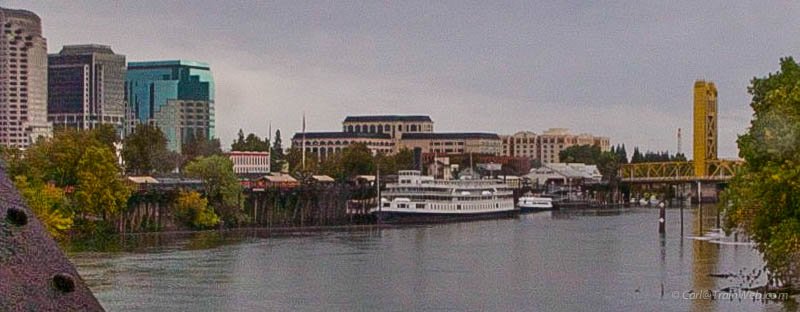 Sacramento, California, from the California Zephyr.
Sacramento, California, from the California Zephyr.
 Mothball Fleet in Suisun Bay, near Martinez, California.
Mothball Fleet in Suisun Bay, near Martinez, California.
Inside the Ghost Ships of the Mothball Fleet
May 7, 2011
By Scott Haefner
For decades, dozens of forgotten Navy and merchant ships have been
corroding in Suisun Bay, 30 miles northeast of San Francisco. These
historic vessels—the Mothball Fleet—served their country in four wars:
WWII, the Korean War, the Vietnam War, and Desert Storm. After a decade
of impasse, the ghost fleet is slowly dwindling as the ships are towed
out one-by-one for scrapping. About 15 retired ships are already gone;
by 2017, the entire fleet will be just a memory.
These ghost ships, part of the National Defense Reserve Fleet (NDRF)
overseen by the U.S. Maritime Administration (MARAD), were supposed to
be ready for duty in the event of a national emergency. Perhaps a few
ships are actually “reserve ready” and could be activated, but the vast
majority are well beyond their useful lives and rotting away as they
wait in line for disposal.
The mothballed ships once numbered close to 400, and in 1959, 324
vessels still lined the waters of Suisun Bay. Although the ships
continued to dwindle down over time, approximately 75 remained
throughout the 2000s, rusting and leaching toxic heavy metals into the
bay as the Bush administration did little to address the crumbling
ships.
Many ships in the fleet served in World War II, including the historic
USS Iowa, the last remaining U.S. lead battleship. Retired war ships
like the Iowa were laid up in Suisun Bay for decades awaiting their
next battle, but the call never came. Instead, they have sat unused and
largely forgotten. But the Iowa will likely see a different fate than
its sister ships who await their ultimate demise at a shipbreaker.
Vallejo is currently in a heated battle with the port of Los Angeles
(San Pedro) to secure rights to the battleship and turn it into a
museum. [Ed.: Since this 2011 article, the Iowa is not in
San Pedro and available for public viewing.]
--From scotthaefner.com/beyond/mothball-fleet-ghost-ships/
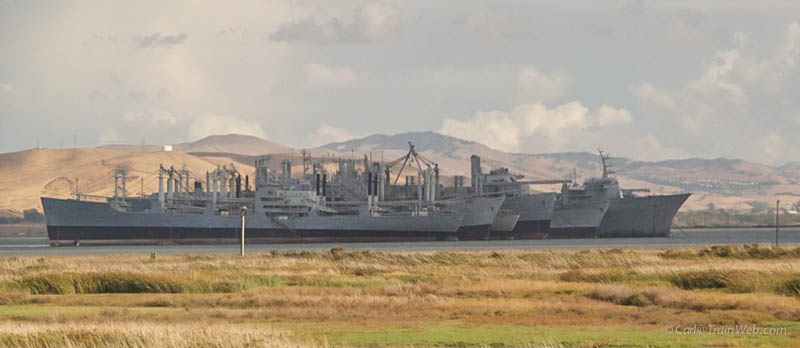
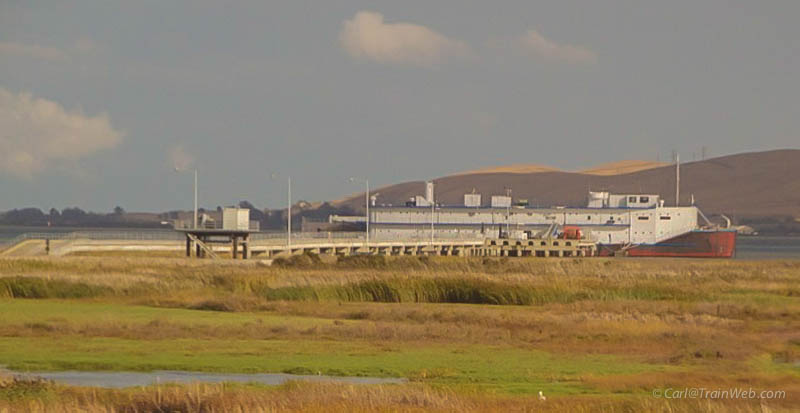

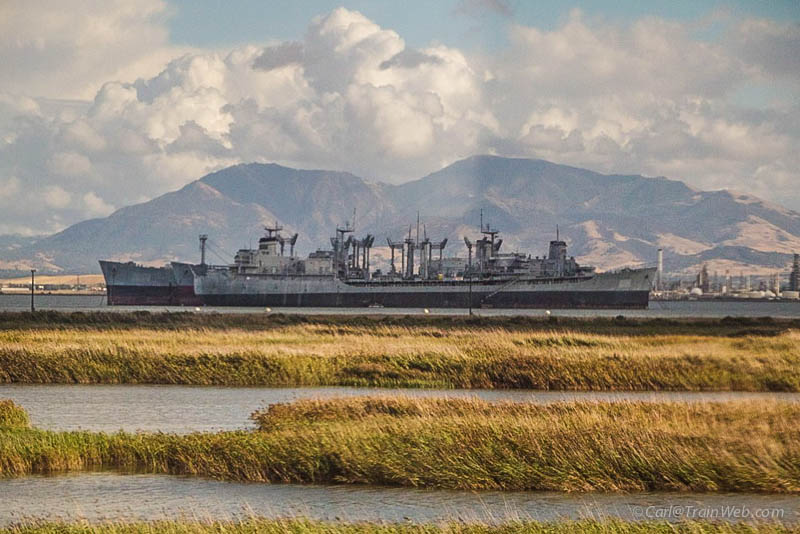
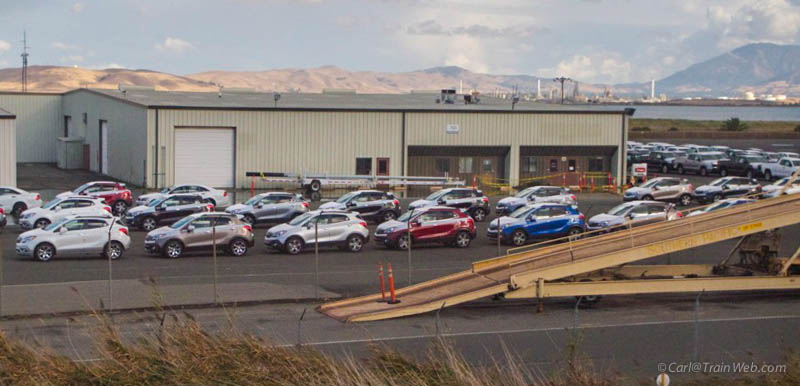 Just beyond Suisun Bay is a loading area for new cars from ocean freighters to rail cars.
Just beyond Suisun Bay is a loading area for new cars from ocean freighters to rail cars.

The Benicia–Martinez Bridge refers
to three parallel bridges which cross the Carquinez Strait just west of
Suisun Bay; the spans link Benicia, in the U.S. state of California on
the north side with Martinez, California on the south. The two
automobile bridges are referred to collectively as "The Benicia Bridge".
Between the two vehicle bridges is a Union Pacific Railroad bridge, the
first bridge at this location, built between April 1929 and October
1930 by Southern Pacific. It is used by Union Pacific and BNSF
(trackage rights) freight trains and 36 scheduled Amtrak passenger
trains each weekday. Passenger trains include the long-distance trains
California Zephyr and Coast Starlight and short-haul Capitol Corridor
trains.
--From en.wikipedia.org/wiki/Benicia%E2%80%93Martinez_Bridge
 1929 - 30 Southern Pacific Bridge
1929 - 30 Southern Pacific Bridge


 C and H (California and Hawaii) Pure Cane Sugar plant with ocean-going freighter dock on the opposite side.
C and H (California and Hawaii) Pure Cane Sugar plant with ocean-going freighter dock on the opposite side.
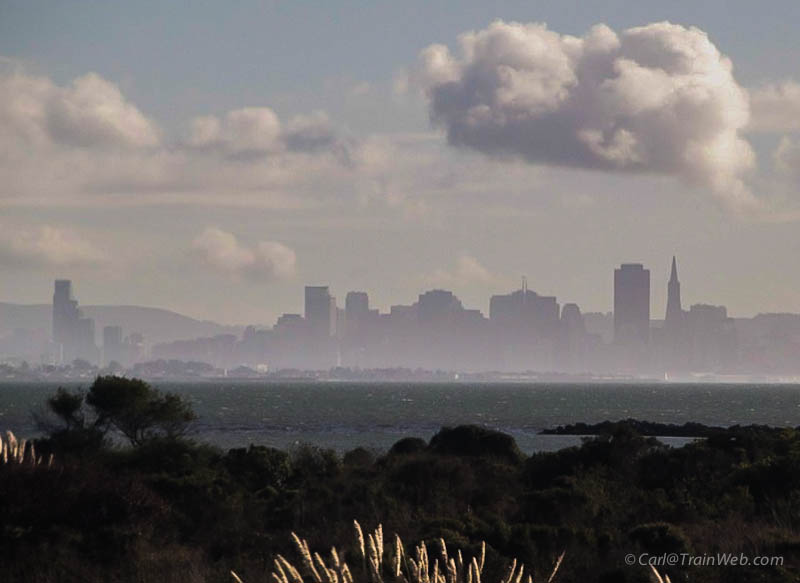 Downtown San Francisco from the California Zephyr before its final destination of Emeryville, California.
Downtown San Francisco from the California Zephyr before its final destination of Emeryville, California.
Do not use "hotelsone" to make your hotel reservations, unless of course you want to pay 50% more than the hotel's rate.
In Emeryville, for our overnight stay before boarding the Coast
Starlight for Los Angeles, I had searched the Internet for reasonably
priced rooms. The best rate was at the Extended Stay America
Oakland - Emeryville. This hotel was not the quality of Motel 8,
nor Motel 6, so let me classify it as a Motel 5, but at a high rate, I
thought. When I checked out the following morning, I saw the rate
and it was 50% lower than what I had reserved with hotelsone.
Further communication with them ended in no change. Therefore, I
urge you not to use hotelsone to make reservations unless you are
willing to pay 50% more for the room that the hotel's rate. I
should have contacted Extended Stay America directly and found the
reasonable price they actually charge.
A short cab ride from the Emeryville Station to Extended Stay America
was accomplished and we asked if there was a restaurant in walking
distance that we could get to before dark. The desk clerk
directed us to "Rudy's". We walked about 3 blocks and found a
restaurant called, Can't Fail Cafe. I asked a passing dog walker
where Rudy's was and she pointed to the Can't Fail Cafe in front of us
and she said she had eaten there the evening before. We went in.
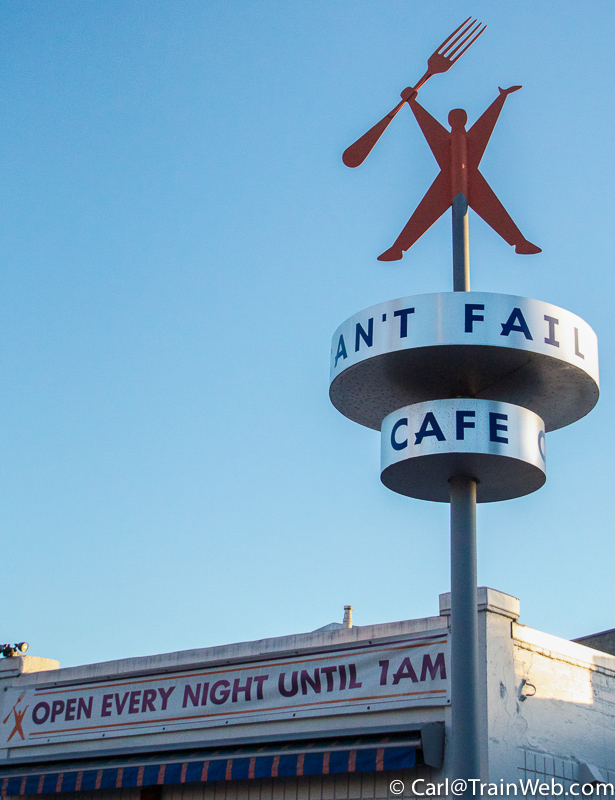
Can't Fail Cafe, known by some as "Rudy's", 4081 Hollis St., Emeryville, CA (iamrudy.com/)
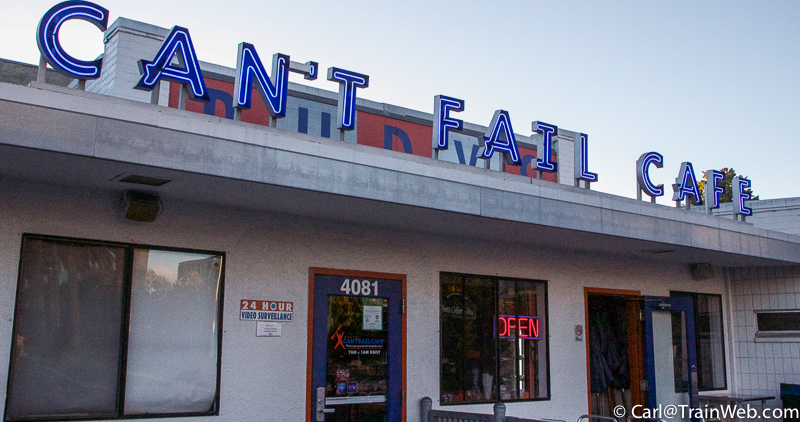
Their recent Health Dept. rating
displayed prominently under their 4081 address number was not "Fail", and
not "Pass", but "Conditional Pass". After seeing this, I wondered
what was conditional about the rating. In any event, I enjoyed my
pulled pork sandwich.
Coast Starlight leaves us standing on the platform in Emeryville - Car Attendant for 1130 never opened the door.
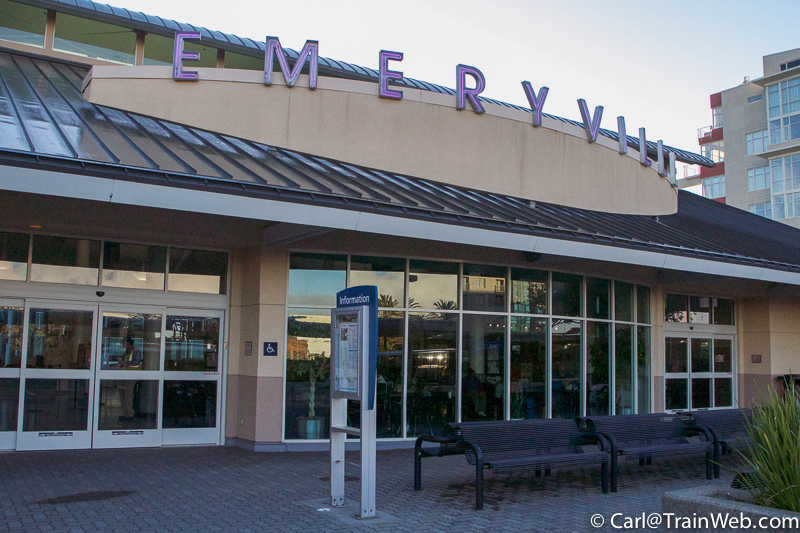
When I went to bed in Emeryville, I
had not turned back my watch from Mountain Time, so we were up an hour
early. There would be breakfast on the Coast Starlight, so no
need to have breakfast before boarding. Extended Stay did have
coffee and mini muffins in the lobby.
After a short cab ride, we were at the station nearly an hour before
departure time for the Coast Starlight, allowing me time to photograph
the station and passing Union Pacific equipment.

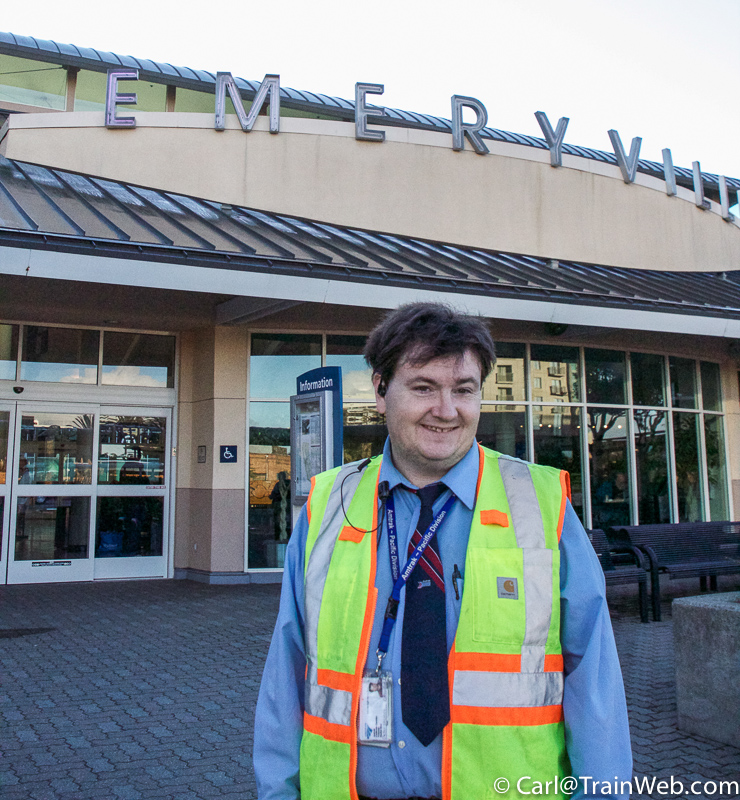 I asked Peter Stewart, employee at the station, about eateries
within walking distance of the station. He listed the Hyatt,
Black Bear, and Denny's.
I asked Peter Stewart, employee at the station, about eateries
within walking distance of the station. He listed the Hyatt,
Black Bear, and Denny's.
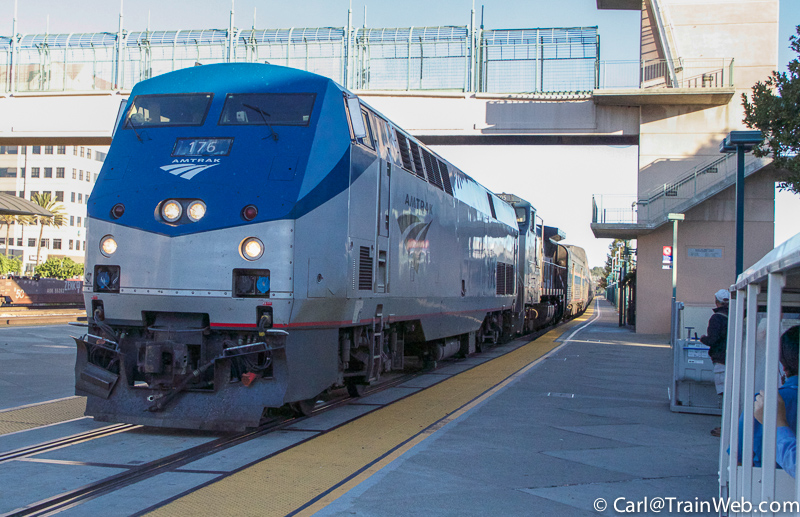 The Coast Starlight pulled into the Emeryville Station and we
walked down the platform to Car 1130 ready to enter our Roomette No. 9.
The Coast Starlight pulled into the Emeryville Station and we
walked down the platform to Car 1130 ready to enter our Roomette No. 9.

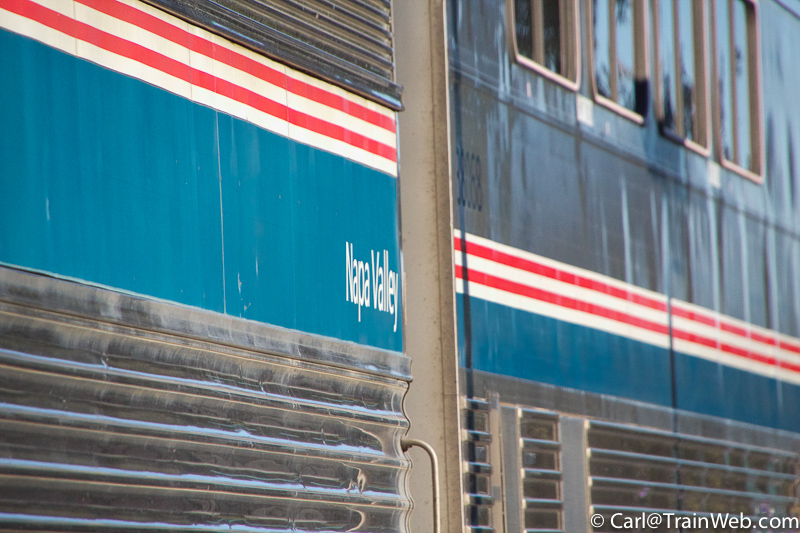 I was so happy to see that the Coast Starlight had a Pacific
Parlour Car in the consist this day that I took a photo of its name,
Napa Valley.
I was so happy to see that the Coast Starlight had a Pacific
Parlour Car in the consist this day that I took a photo of its name,
Napa Valley.
The Coast Starlight pulled out of
the station and we were dumbfounded. No car attendant had opened
the door to admit us even though my 5-month old reservation should have
shown that we were to be in Roomette 9 boarding at Emeryville and going
to Los Angeles. No conductor came anywhere near any of the
sleepers. We went back into the station and talked to the ticket
agent. She said, do you want to go tomorrow. Ah, let's see,
another expensive hotel night in Emeryville, 3 meals and no offer of
compensation nor any knowledge if there was room for us the next day,
we said no thanks. Next they offered us a chance to take a train
from Emeryville to Bakersfield and a bus to Los Angeles, and a train on
out to Fullerton. Not a ride on the Coast Starlight, the
longest ocean-view train ride in America and having a roomette for the
day with 3 meals in the diner or parlour car, just a train/bus/train
ride home. We took the same-day option.
Upon our return home, I phoned Amtrak Guest Rewards and asked for my
15,000 points back - the same amount of points it would take to take
the ride in a roomette from Emeryville to Fullerton. They offered
4,000 pts. back - why I do not know. I asked to speak to a
supervisor and instead was transferred to 1-800-USA rail (who could not
give me my points back because they are not Amtrak Guest
Rewards). They "started a complaint and gave me the case
number." I have since written them explaining the situation again
and asking for the 15,000 points back.
When I get the final response, I will post it here. As it now
stands, we were left at the station through Amtrak's fault and they are
unwilling to make the error right.

After waiting 2 more hours, using
the Internet to work on this report, our Amtrak California train
arrived and we headed back up the tracks to Martinez, then turned south
to Bakersfield.
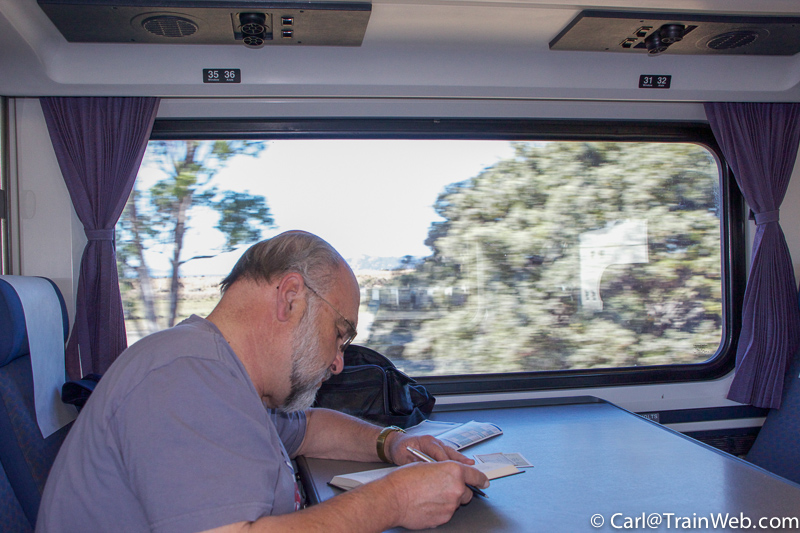
Don was much less upset than I
about being left in Emeryville and calmer minds prevailed. The
Amtrak California car had tables so he could do his reading and I
settled down and began taking a few photos, after buying a meal in the
cafe car.
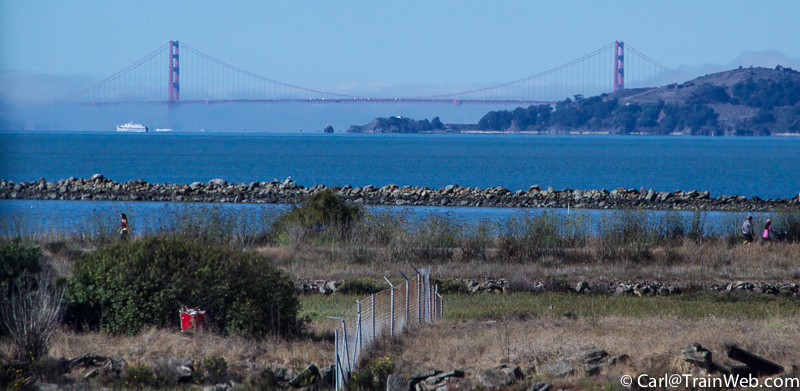 We had another look at the Golden Gate Bridge as we retraced our tracks back to Martinez.
We had another look at the Golden Gate Bridge as we retraced our tracks back to Martinez.
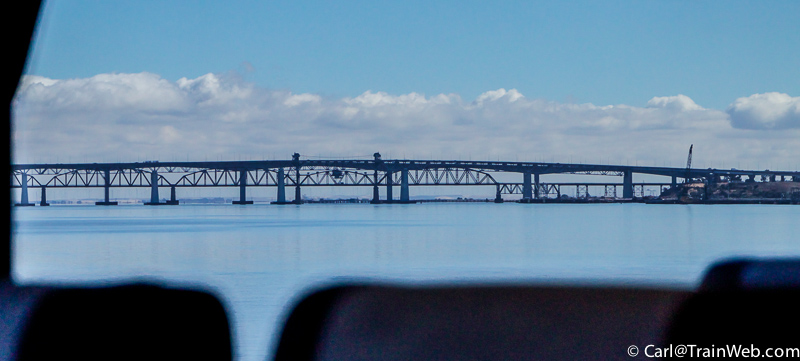
We again saw the Benicia–Martinez Bridge with the Union Pacific Railroad
Bridge between, that we had crossed the last afternoon. We did
not cross the railroad bridge this day, instead we turned right and
headed down the valley to Bakersfield.
 Residential cars on the Ringling Circus Red Unit Train
Residential cars on the Ringling Circus Red Unit Train
Don pointed out the Ringling Bros.
and Barnum and Bailey train, stationary on a siding. It was the
red unit identifiable by the red shields on the ends of each car.
The blue unit is elsewhere in the US. Ringling has the two trains
to carry performers, staff, equipment, and concessions. Either
the red or the blue units qualify as the longest private train in the
world. I report on the Circus Train each summer when it is in
Anaheim, California, and you can see those reports at trainweb.org/carl.

Residential cars with the middle
door for 1/2-car accommodations for the ringmaster and family; and
trainmaster and family; and other high-ranking performers or officials.

Since I was not sure where we were
at the time we saw the circus train, I looked up at a freeway sign and
realized that we were in Stockton where the circus was performing.
 At the Stockton station, to start our trip we had departed a train and took a bus to
Sacramento from here. Glad we did not have a bus ride at
this point this time.
At the Stockton station, to start our trip we had departed a train and took a bus to
Sacramento from here. Glad we did not have a bus ride at
this point this time.
 We were now at Stockton on the map that was posted on our train. You can see the stops we made on our way to Bakersfield.
We were now at Stockton on the map that was posted on our train. You can see the stops we made on our way to Bakersfield.
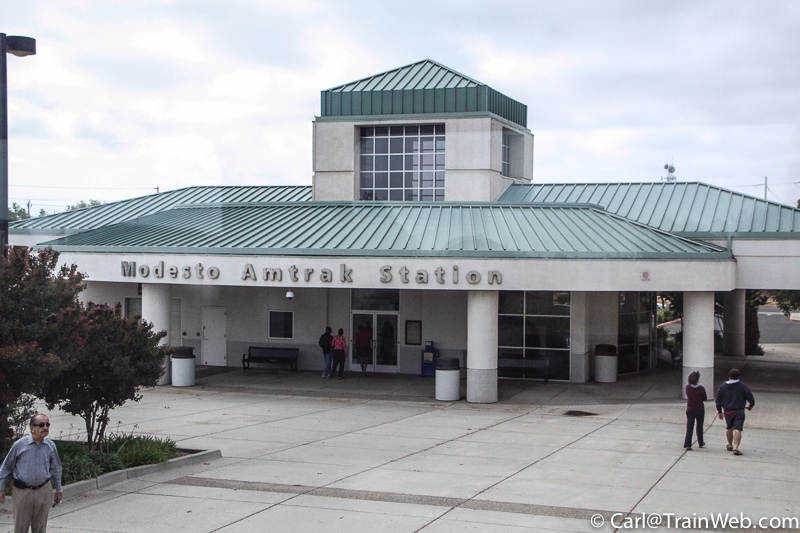
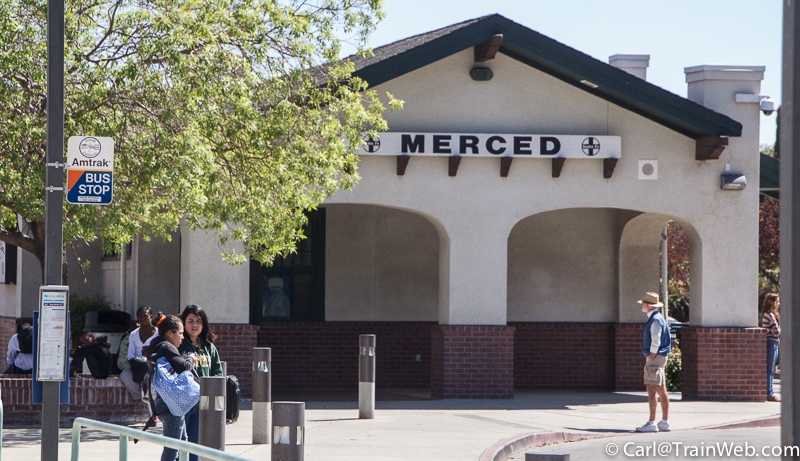
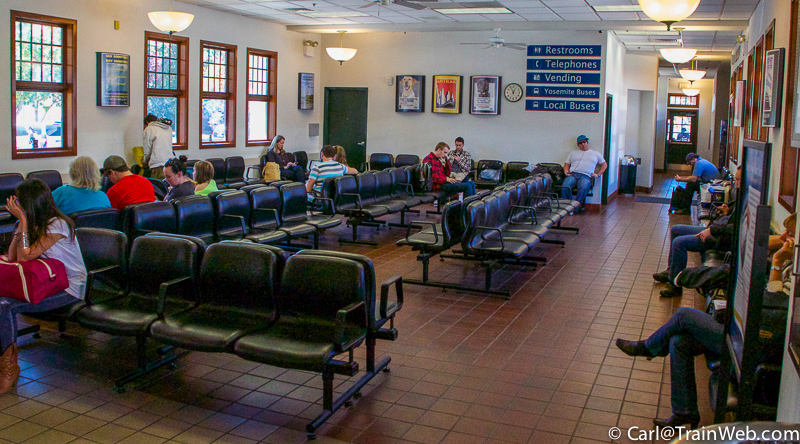

 Fresno Station
Fresno Station
We took the bus from Bakersfield to Los Angeles and a Surfliner on to
Fullerton. Our original Destination, Glenwood Springs, Colorado, was a
great success. The Hotel Denver was the perfect railfan's hotel
with its station and track view rooms. We were able to change our
schedule to board the westbound California Zephyr in Denver rather than
Glenwood Springs where rail travel had been terminated because of the
severe flooding in Colorado. We enjoyed the Southern Wyoming
reroute which I had not taken since 2004. The only sore point was
being left on the platform, through no fault of our own, on our final
portion of the trip from Emeryville to Los Angeles on the Coast
Starlight.








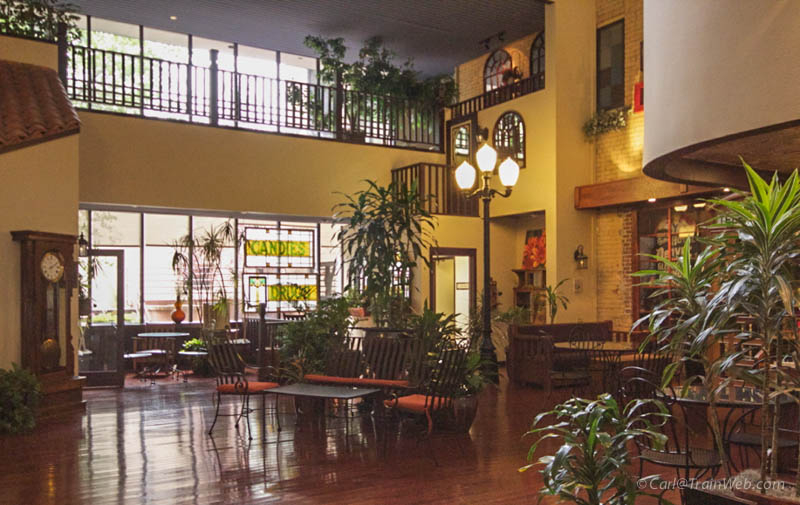


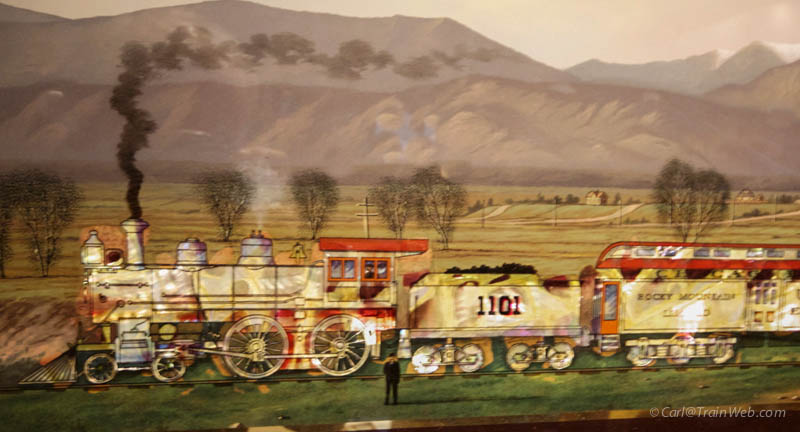




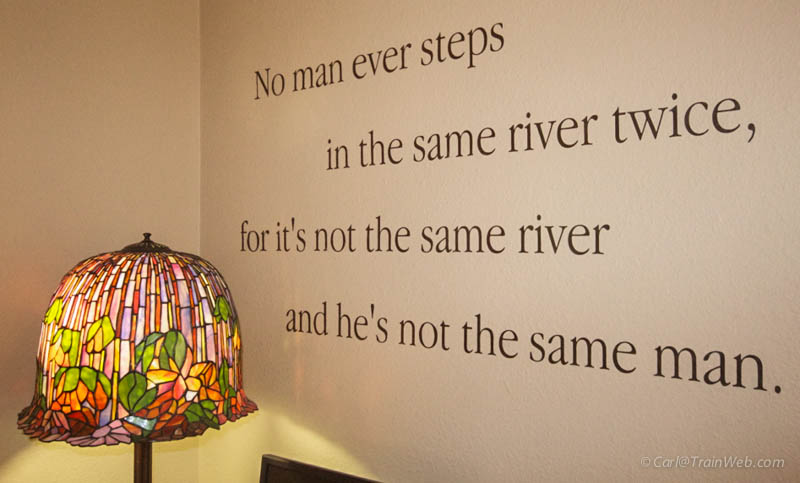




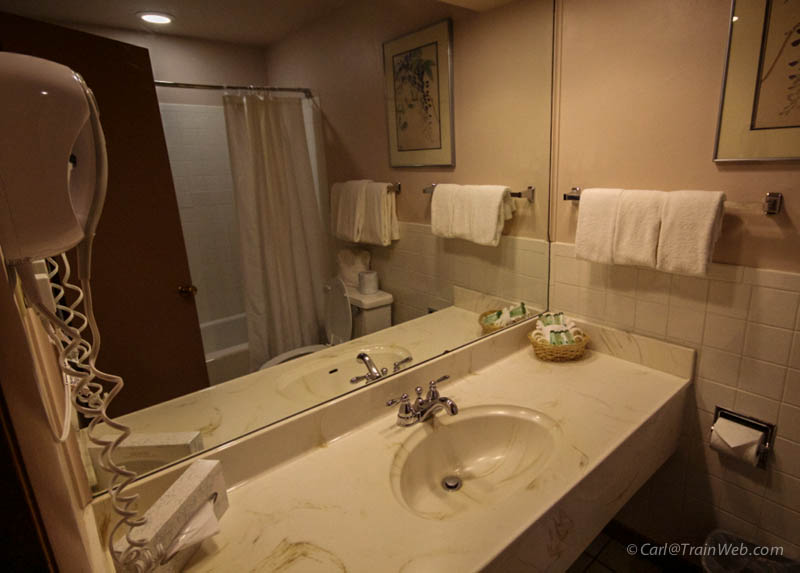











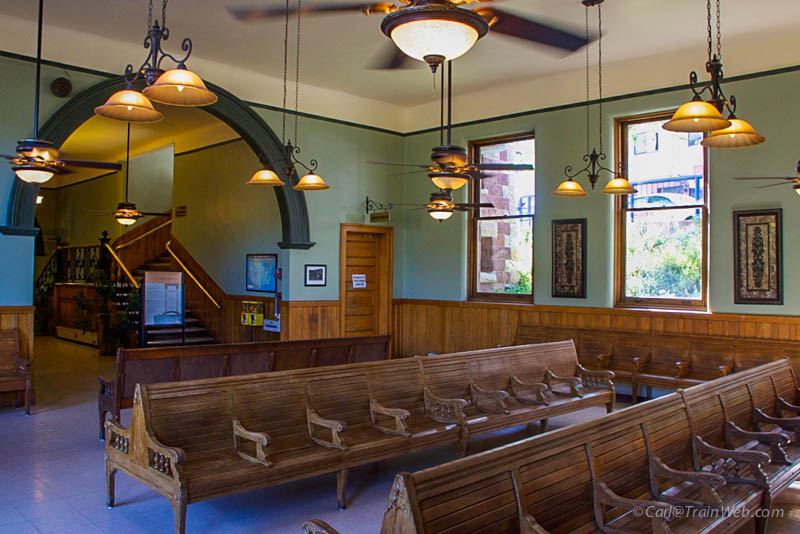









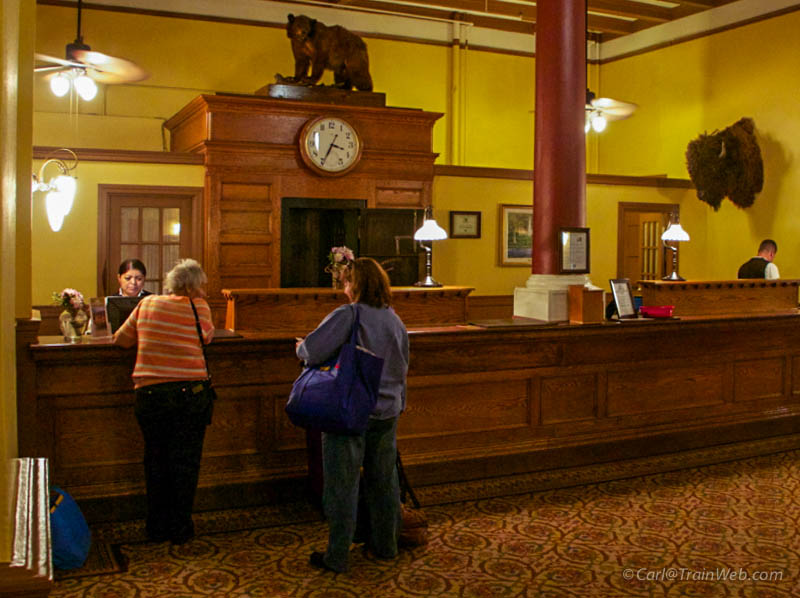

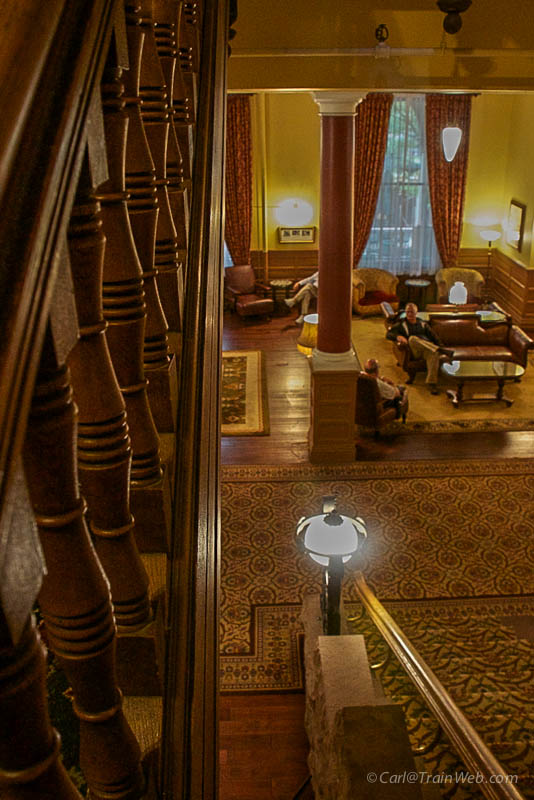


















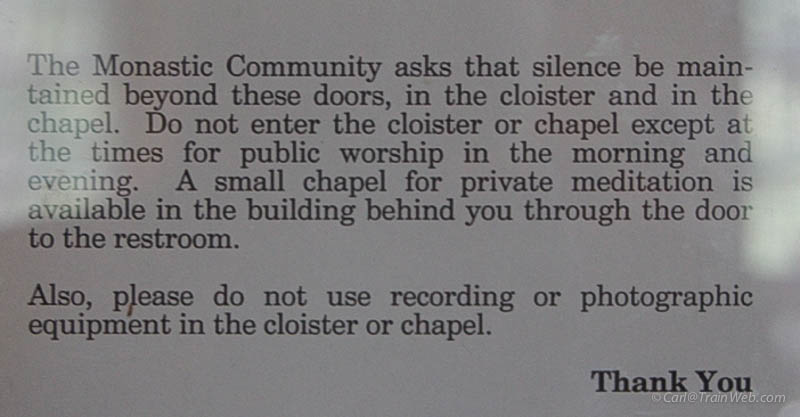




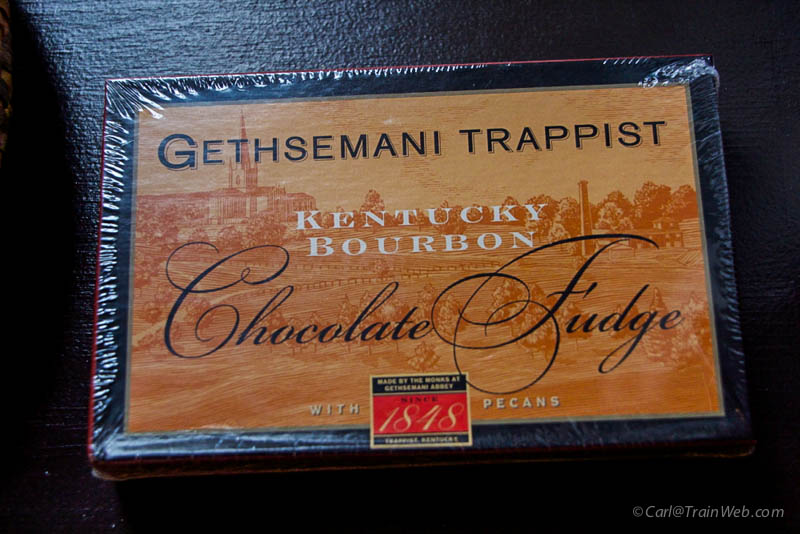
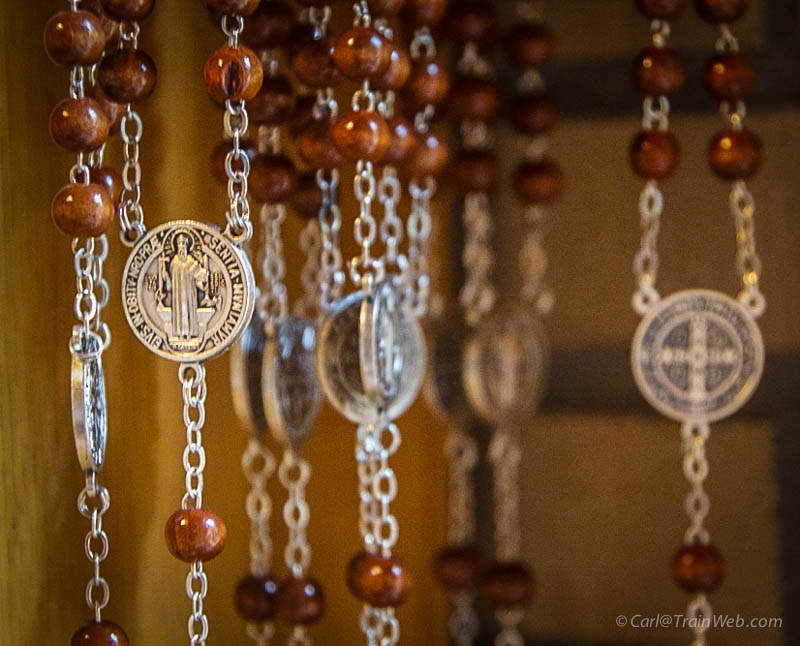
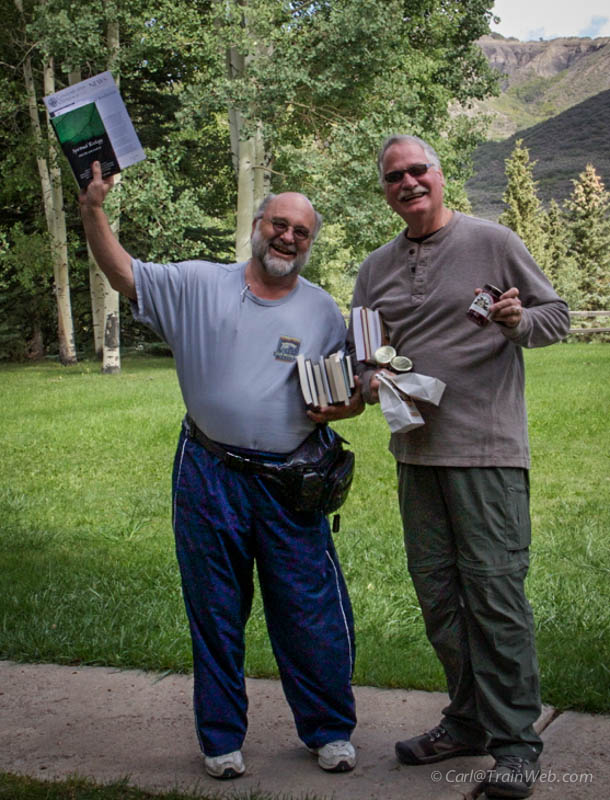
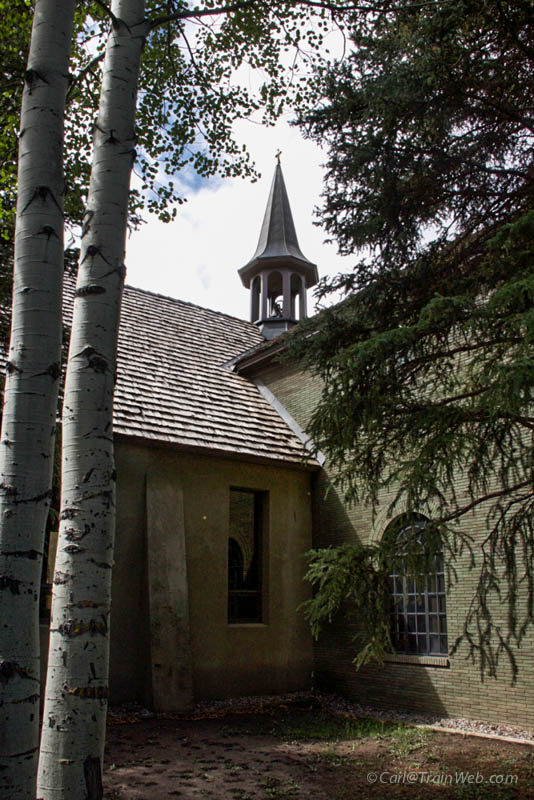
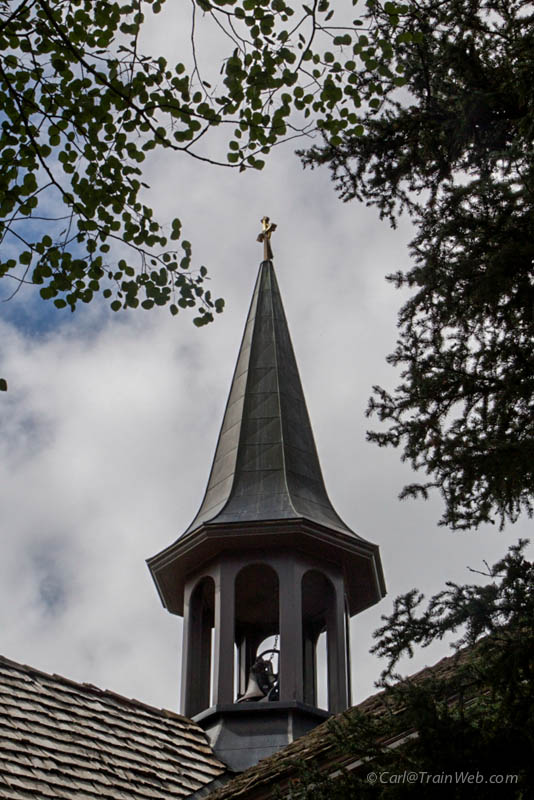

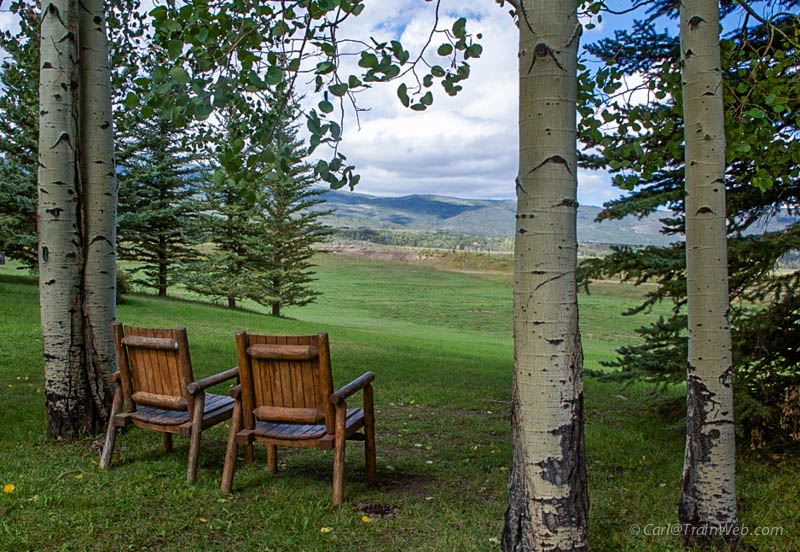

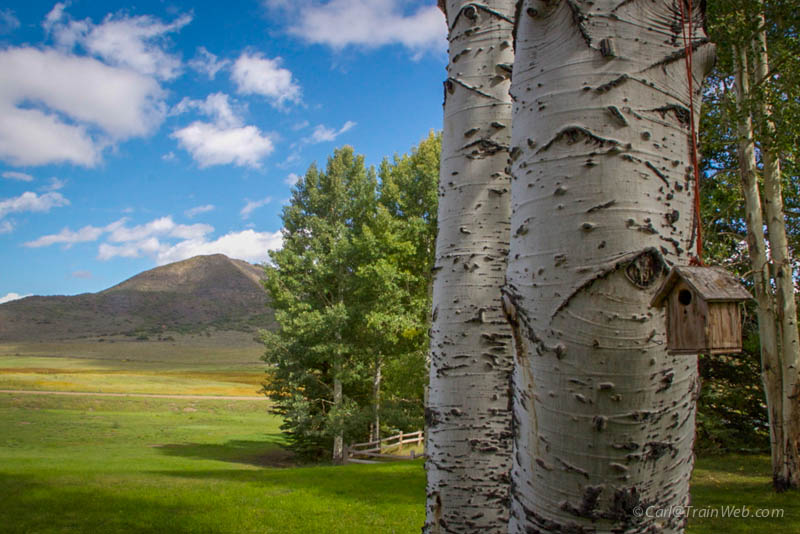
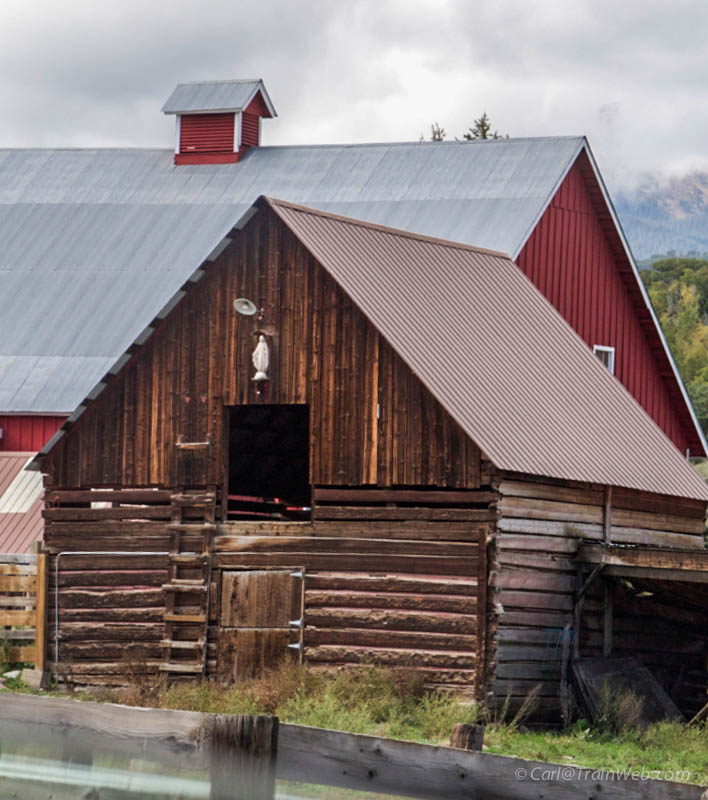
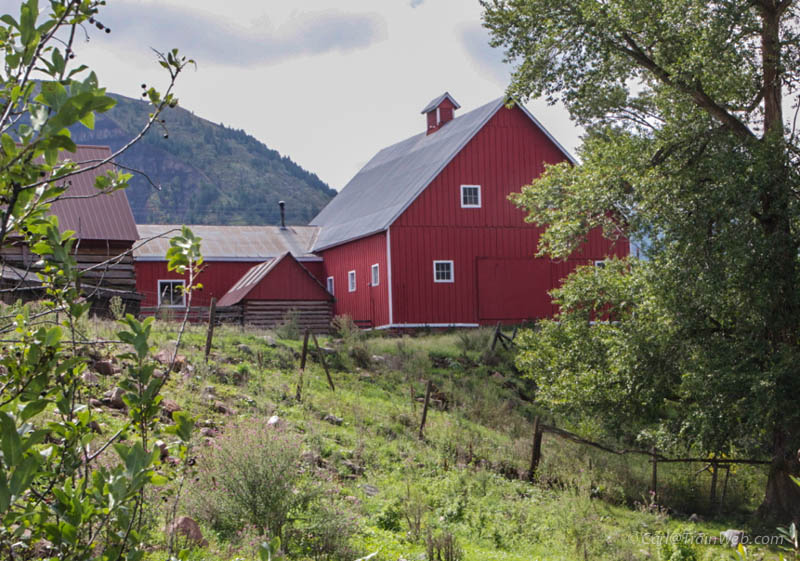











































 Trails
& Rails is an innovative partnership program between the National
Park Service and Amtrak, providing rail passengers with educational
opportunities that foster an appreciation of a selected region's
natural and cultural heritage. It also renews the long tradition of
connecting railroads with National Parks.
Trails
& Rails is an innovative partnership program between the National
Park Service and Amtrak, providing rail passengers with educational
opportunities that foster an appreciation of a selected region's
natural and cultural heritage. It also renews the long tradition of
connecting railroads with National Parks.








































































































































